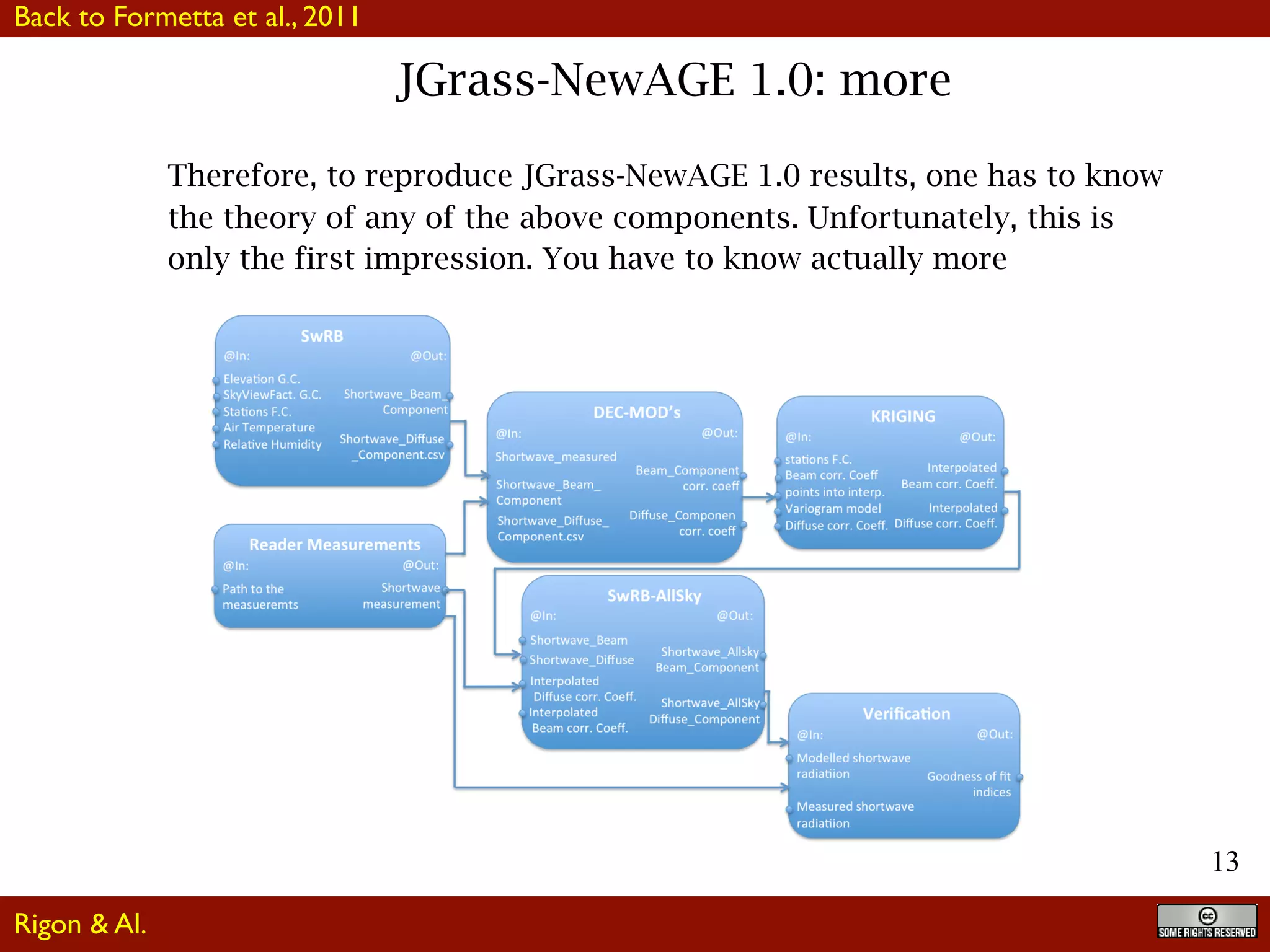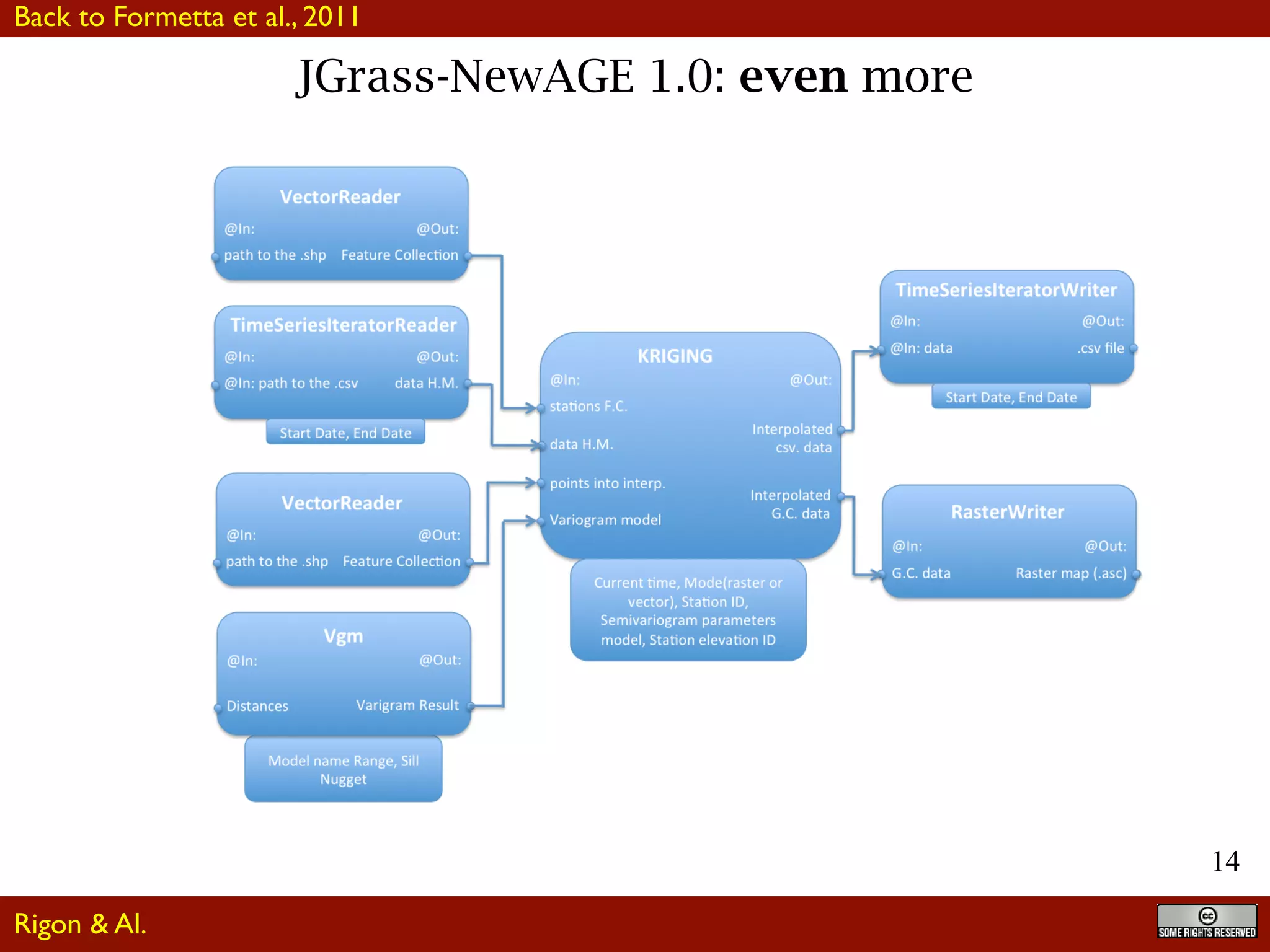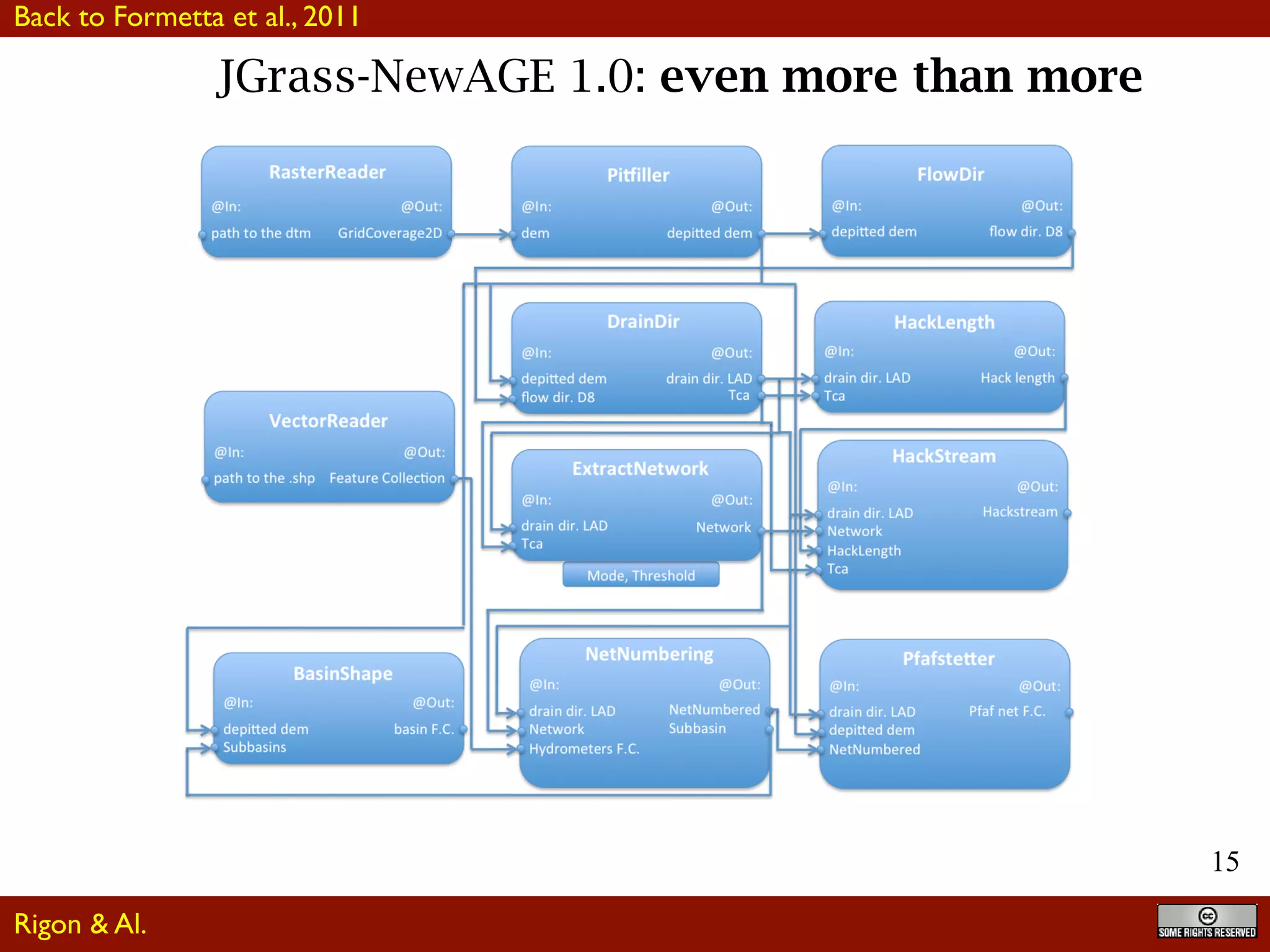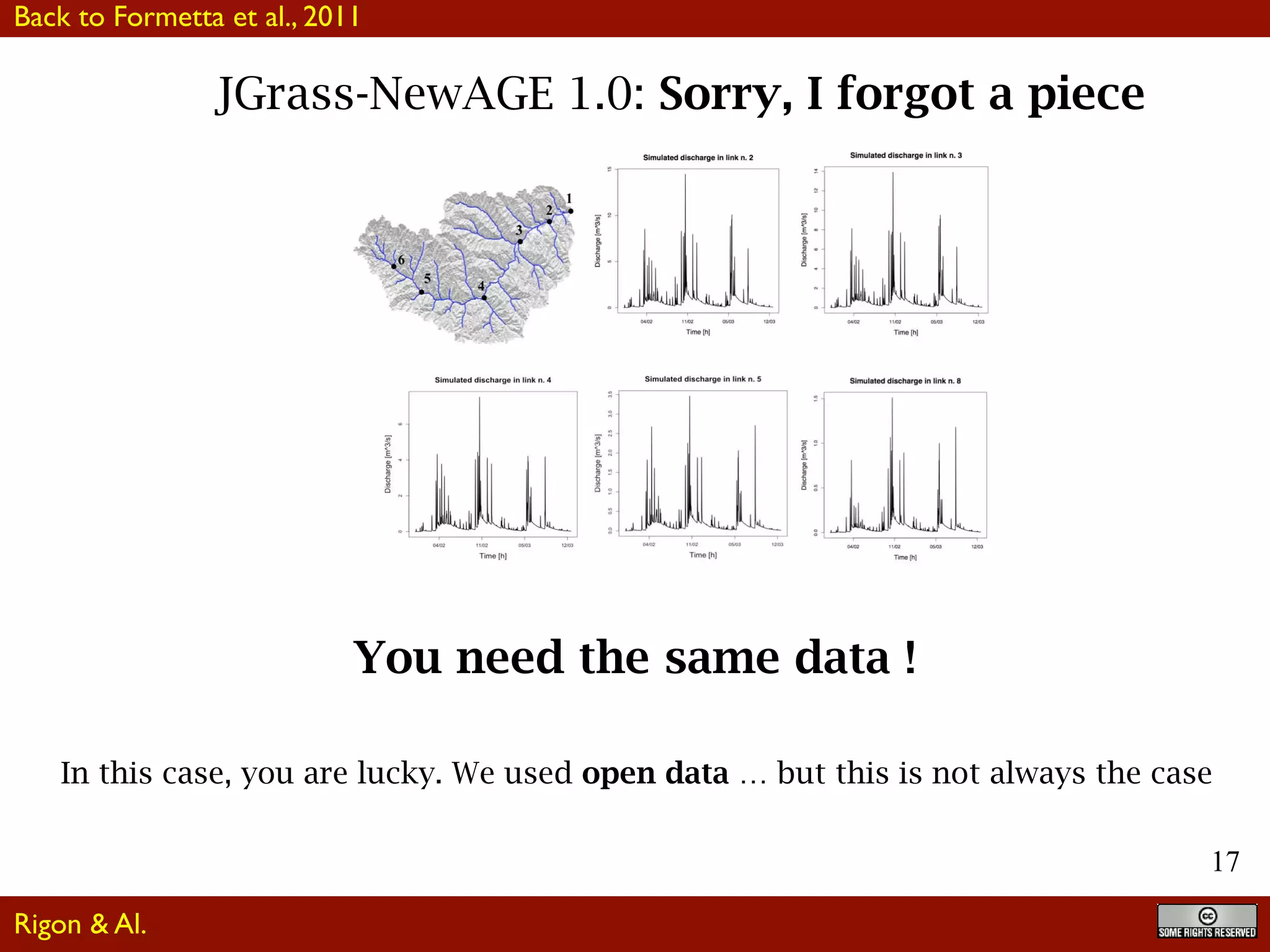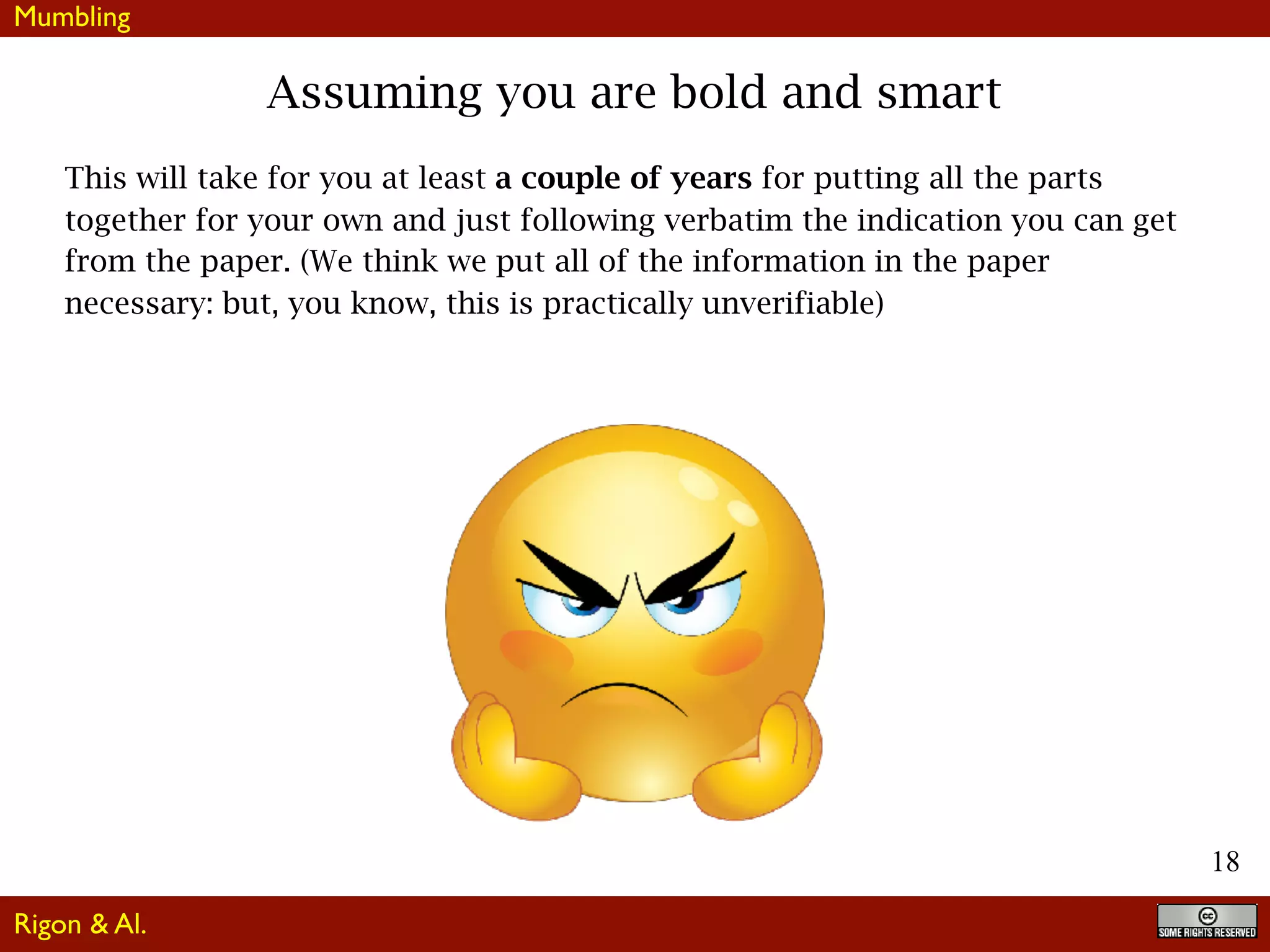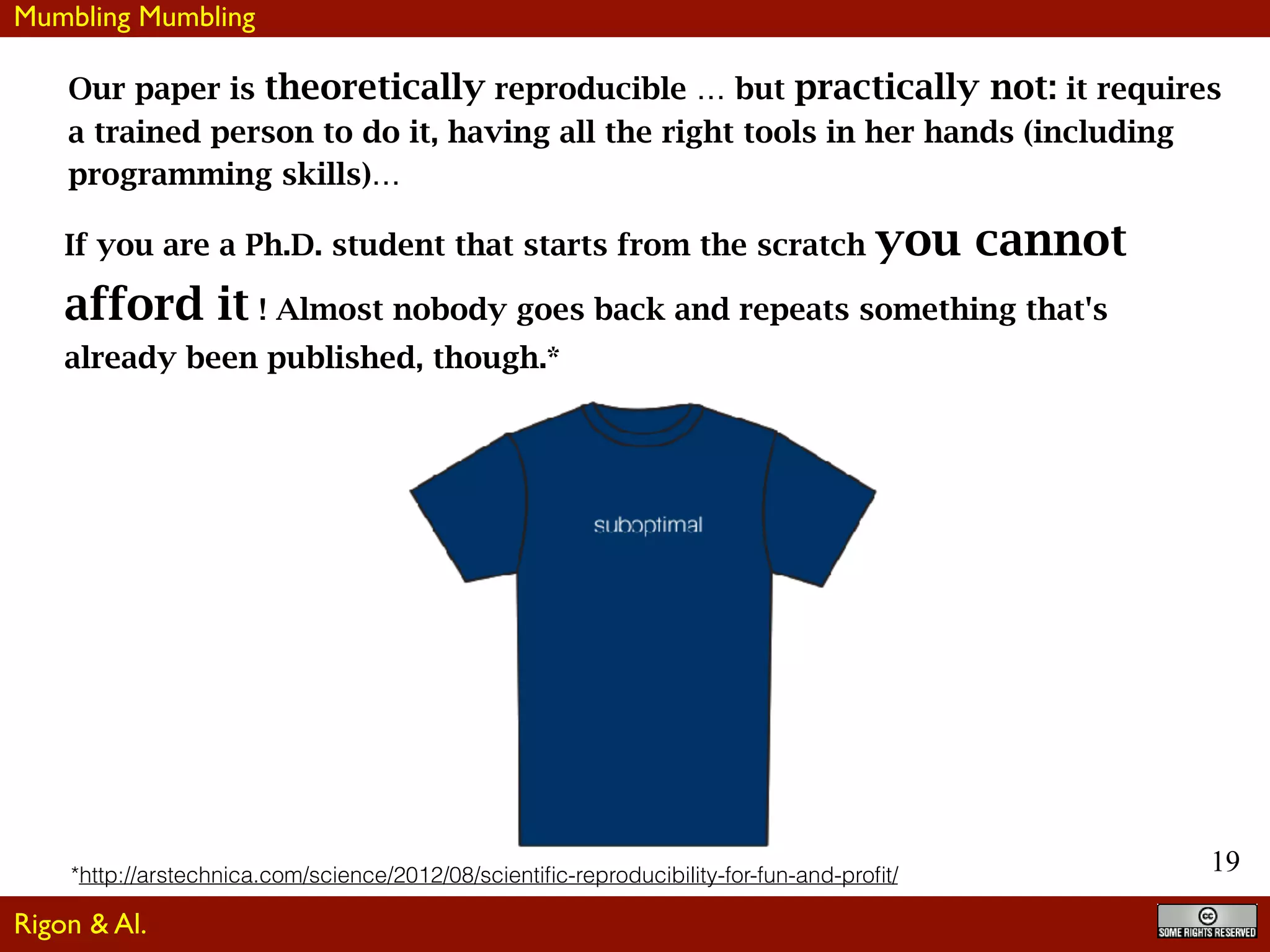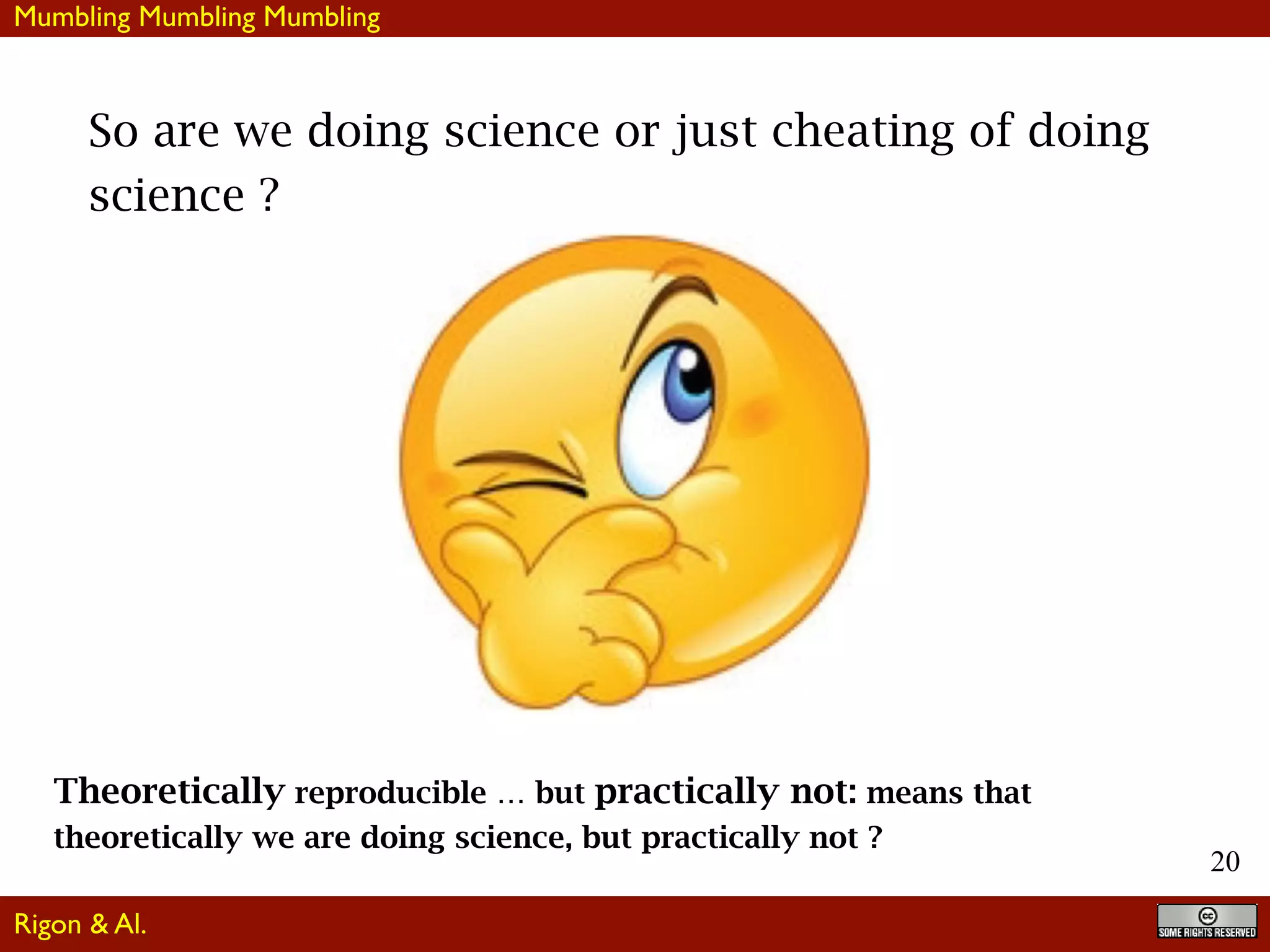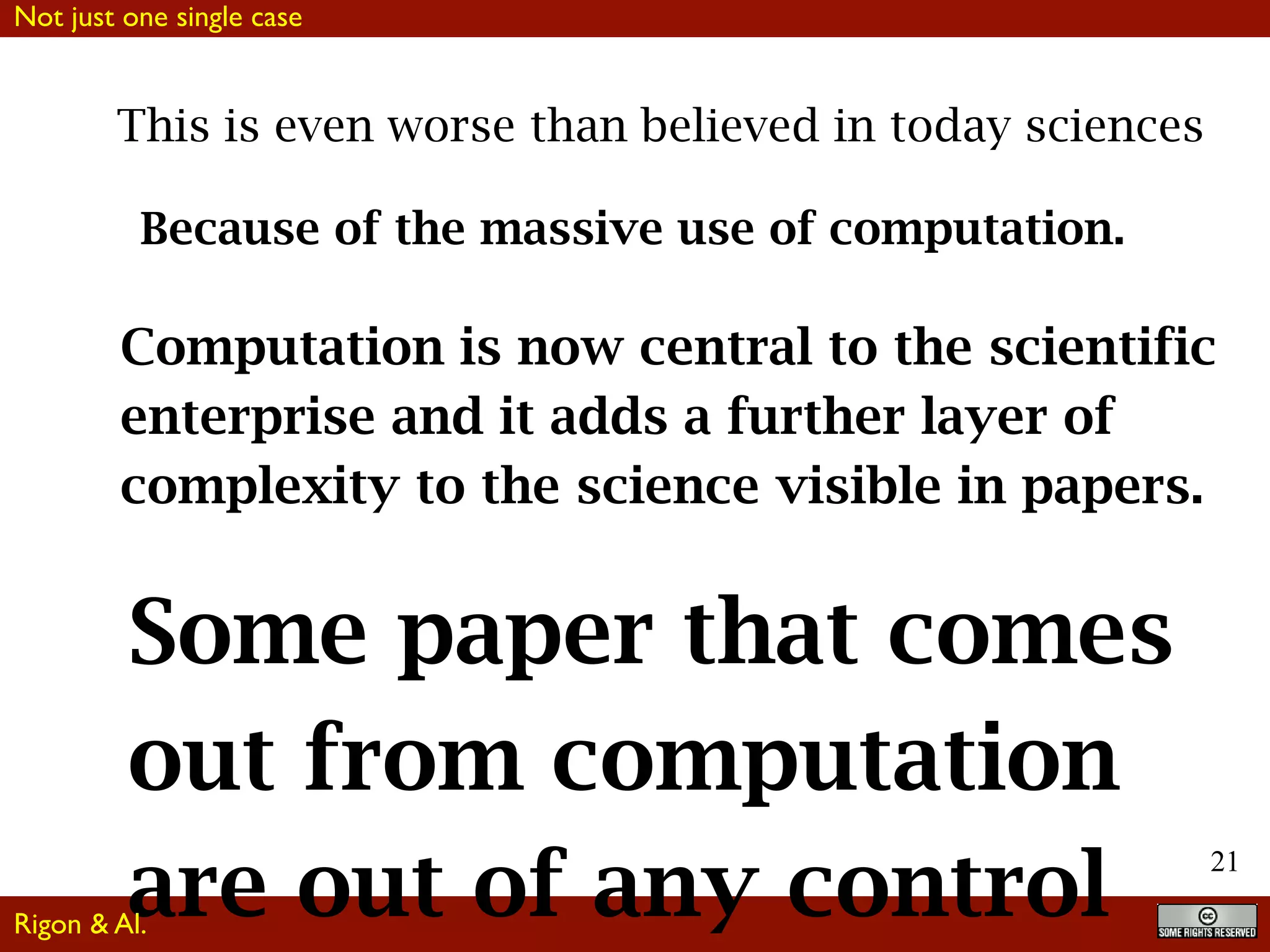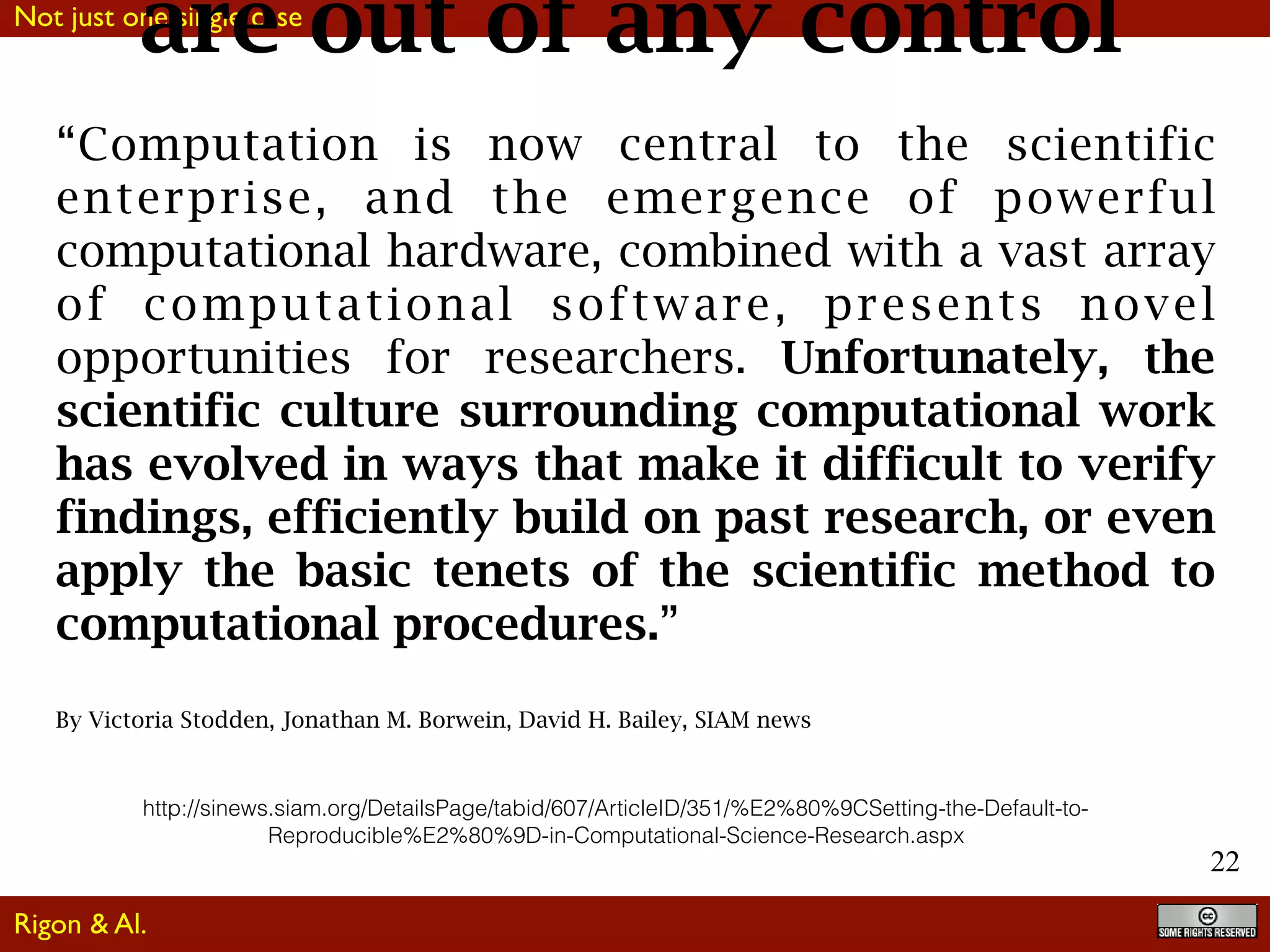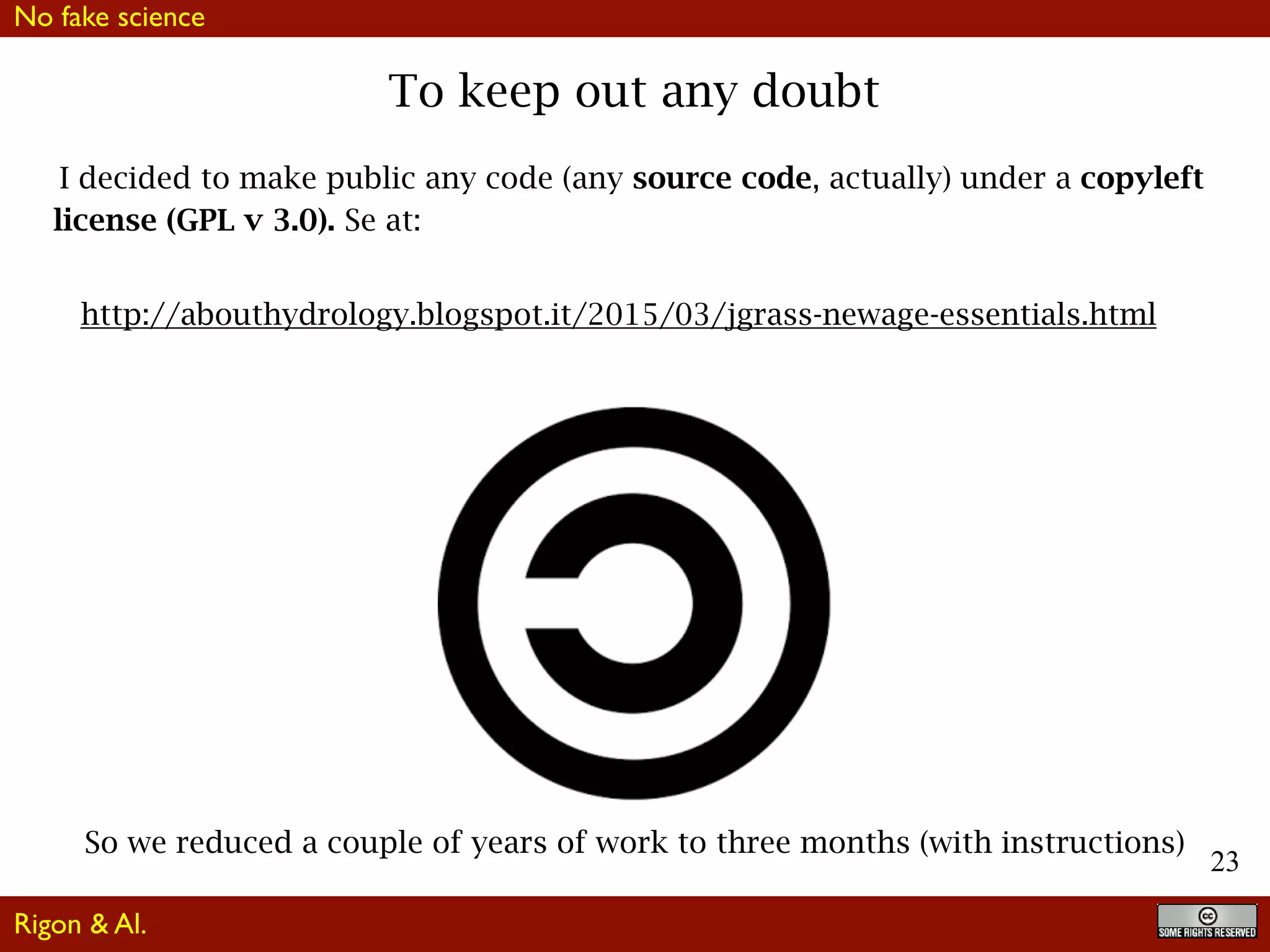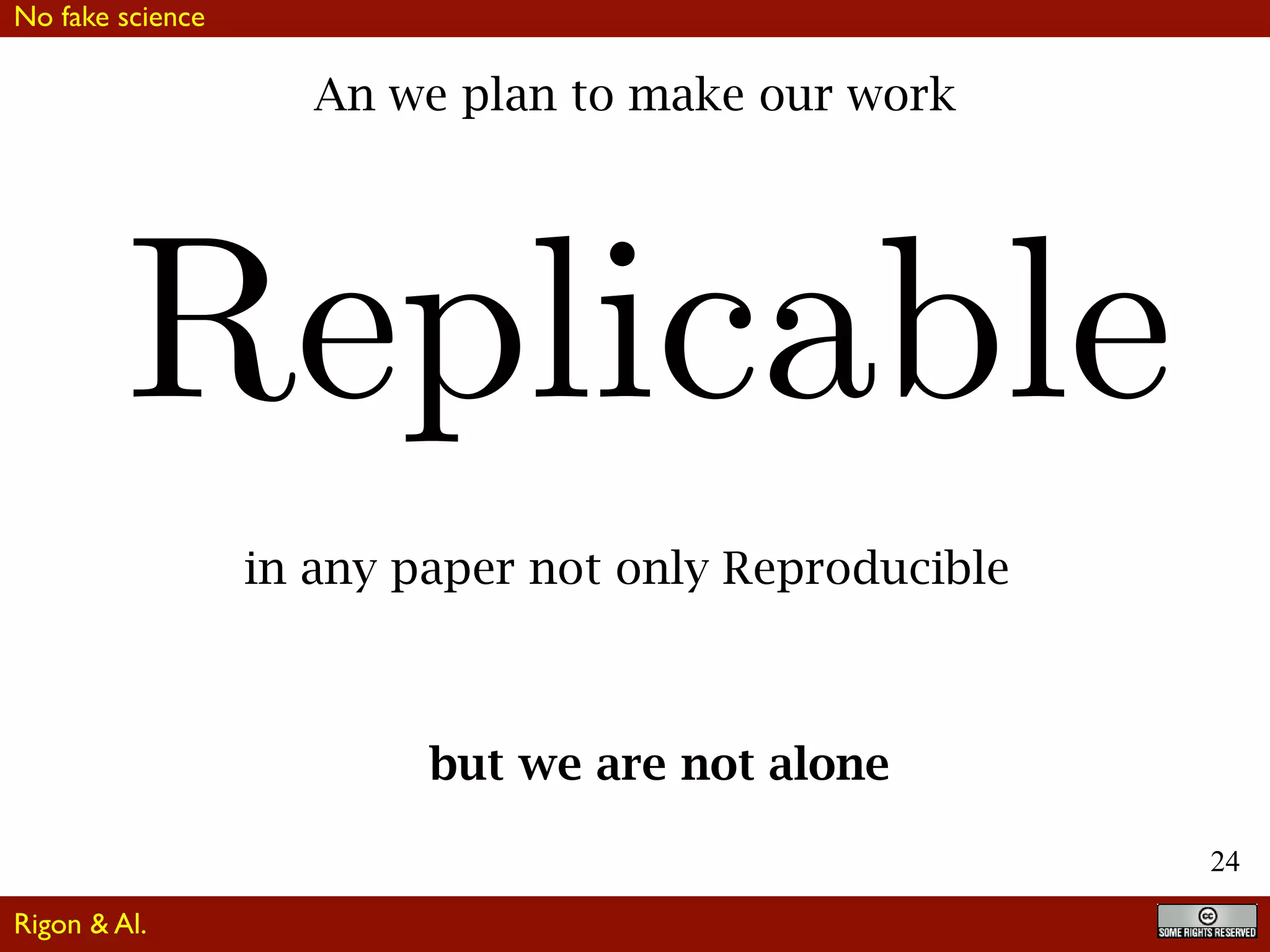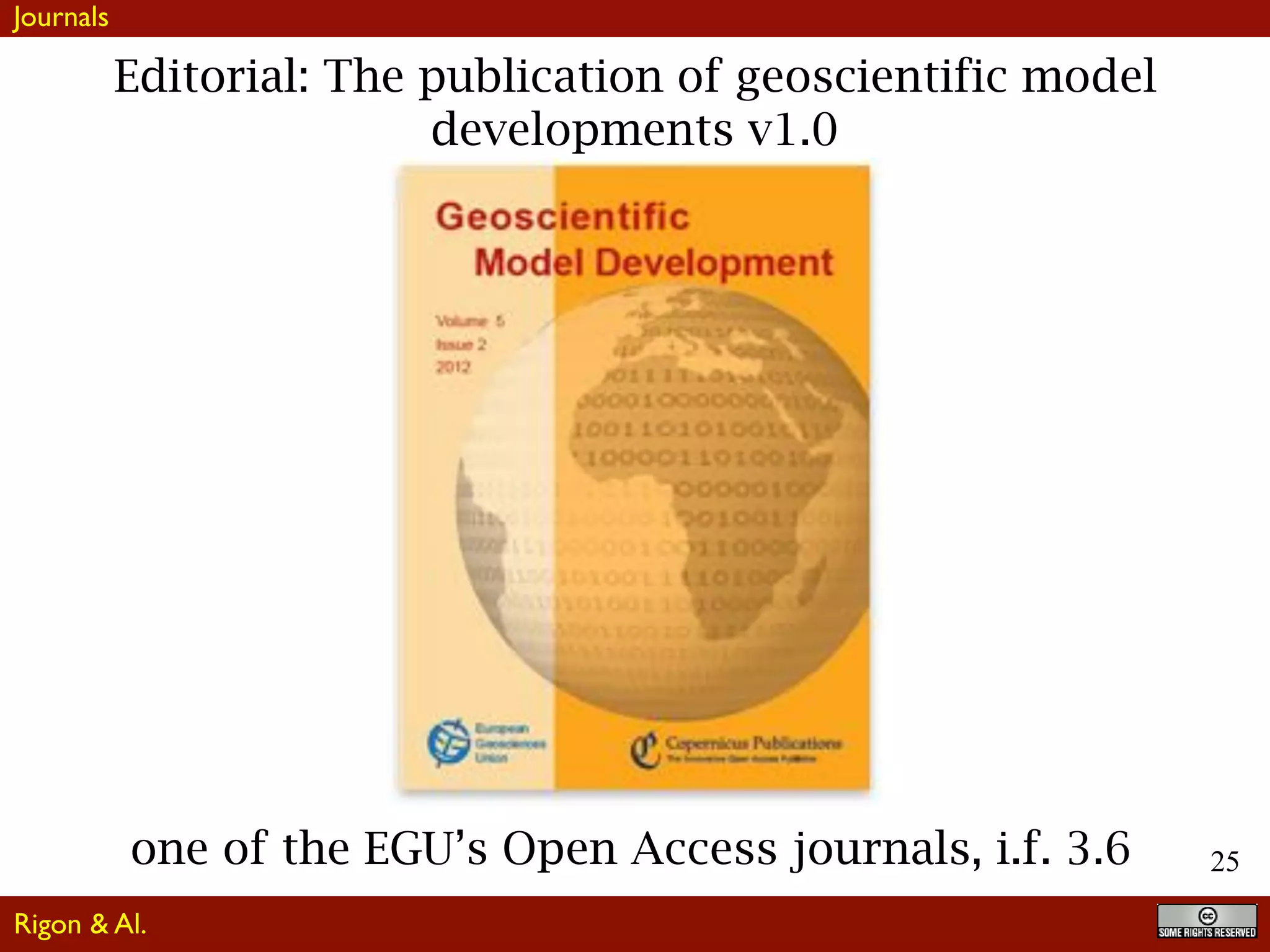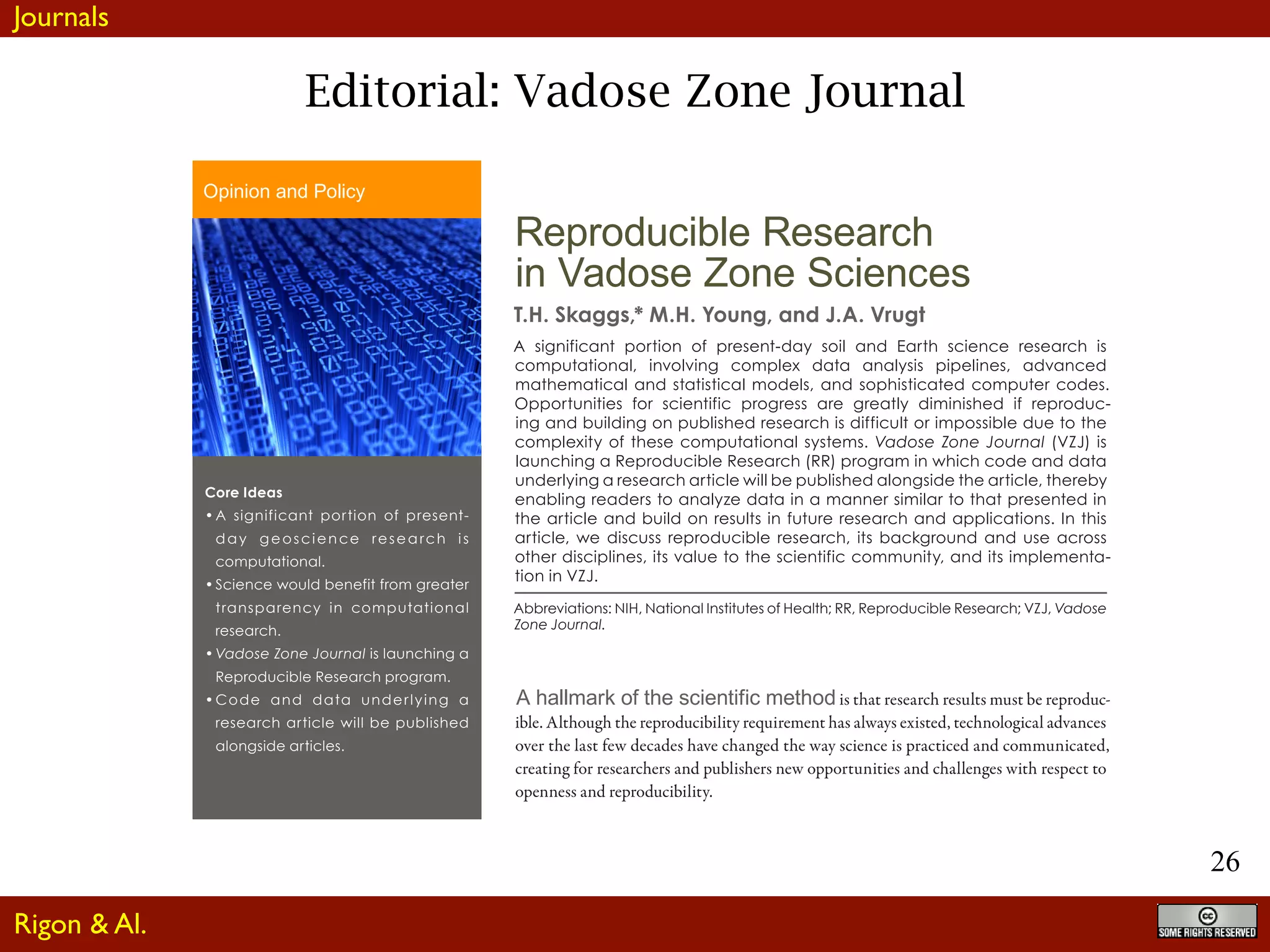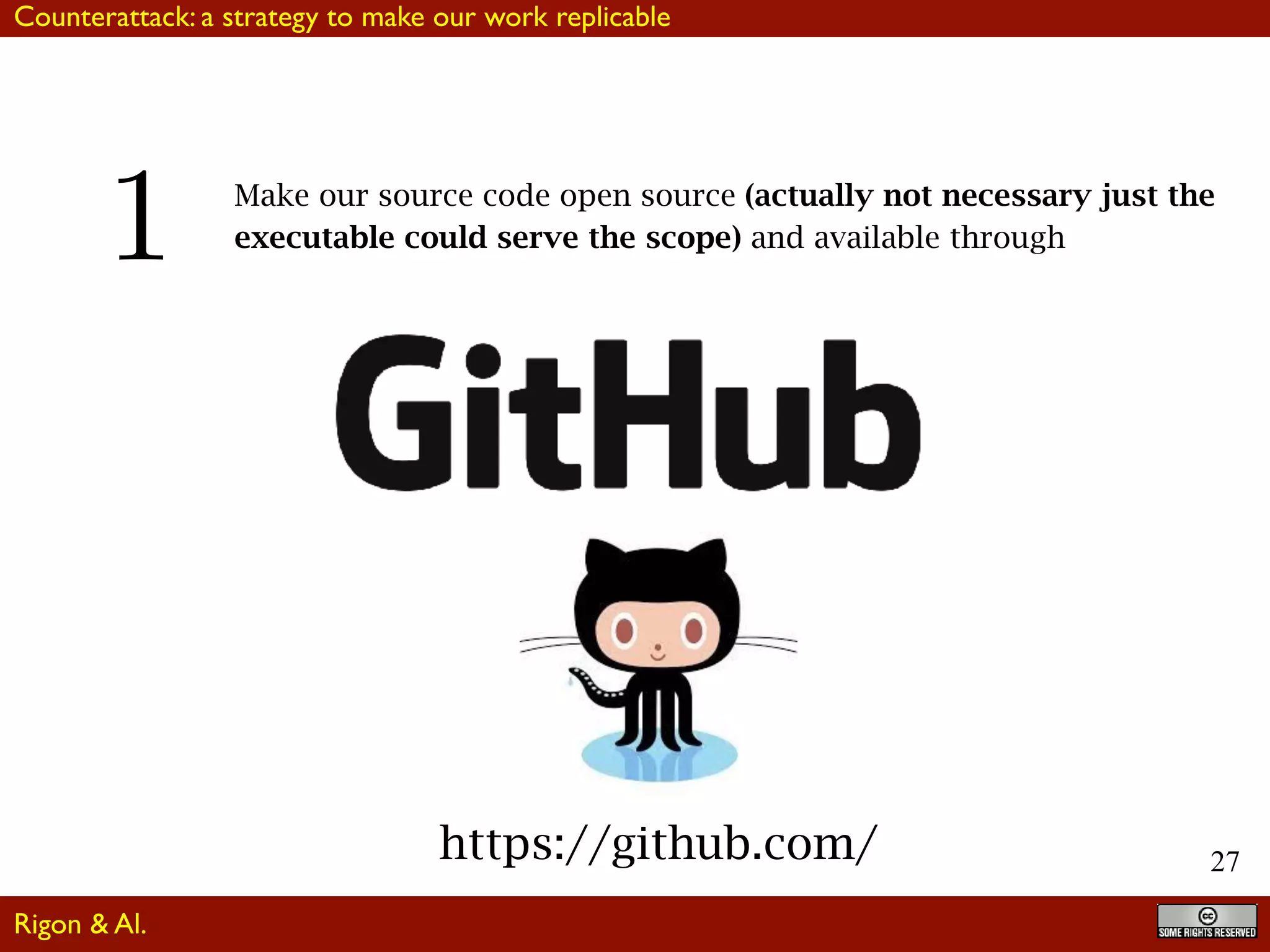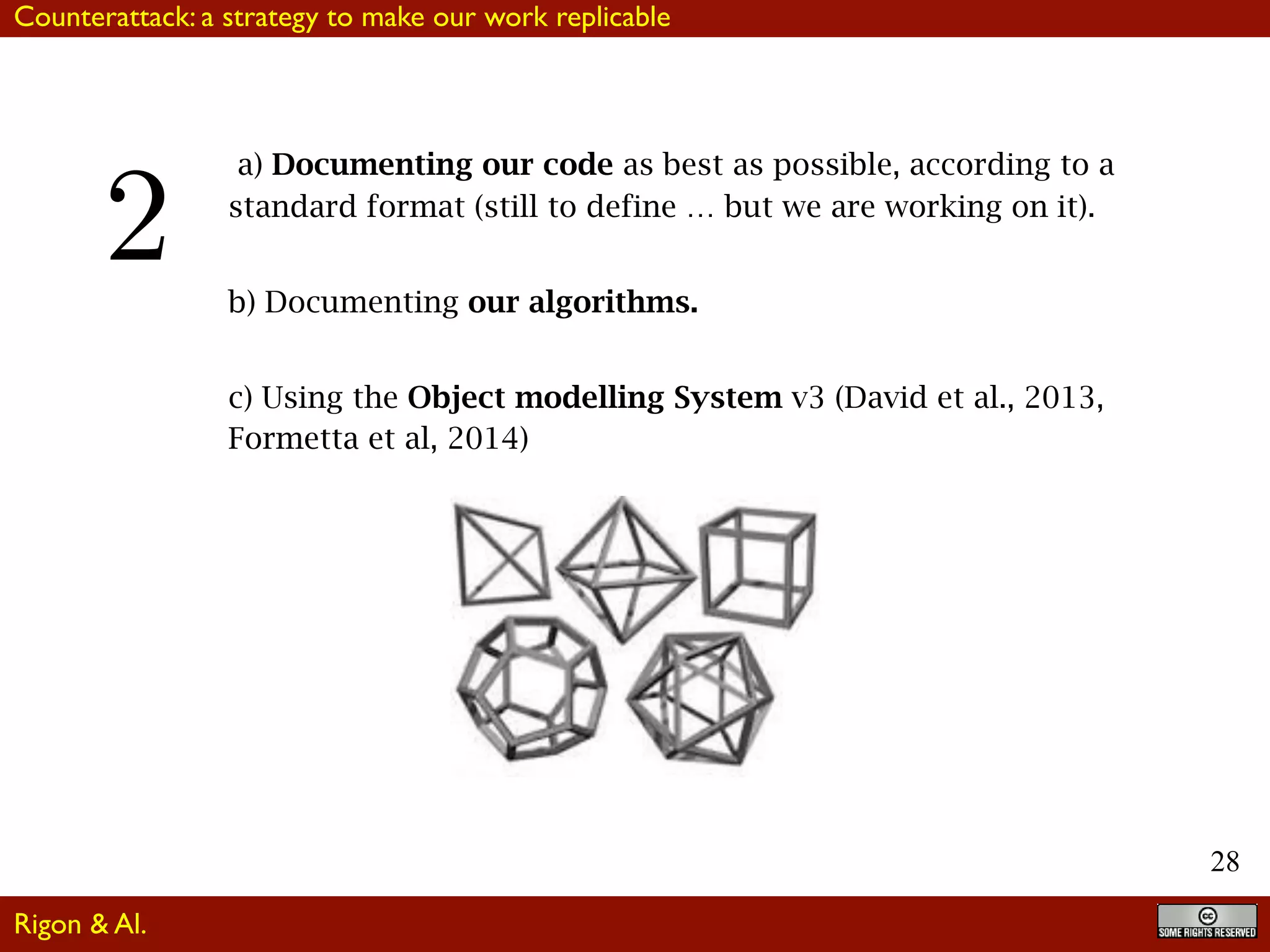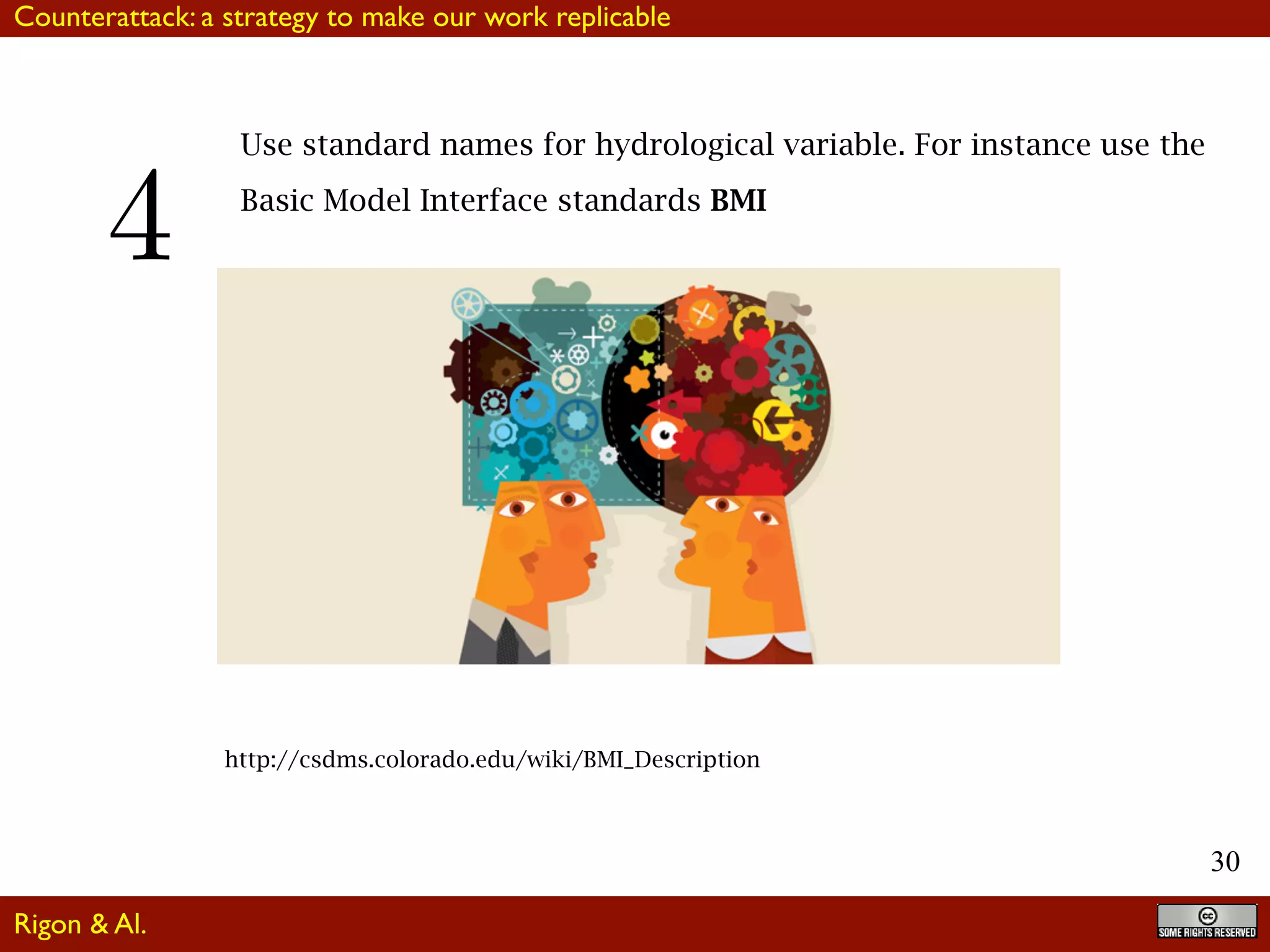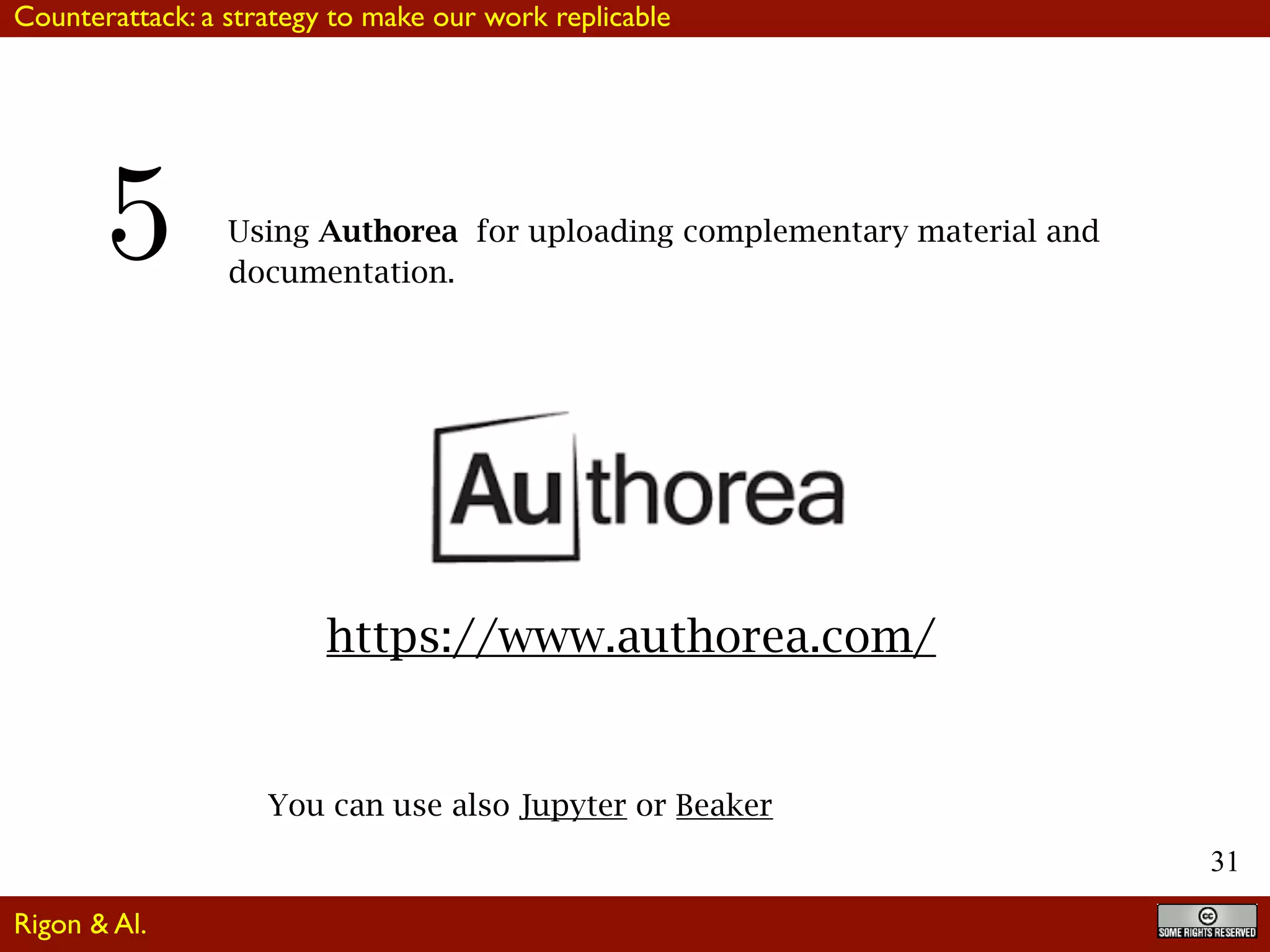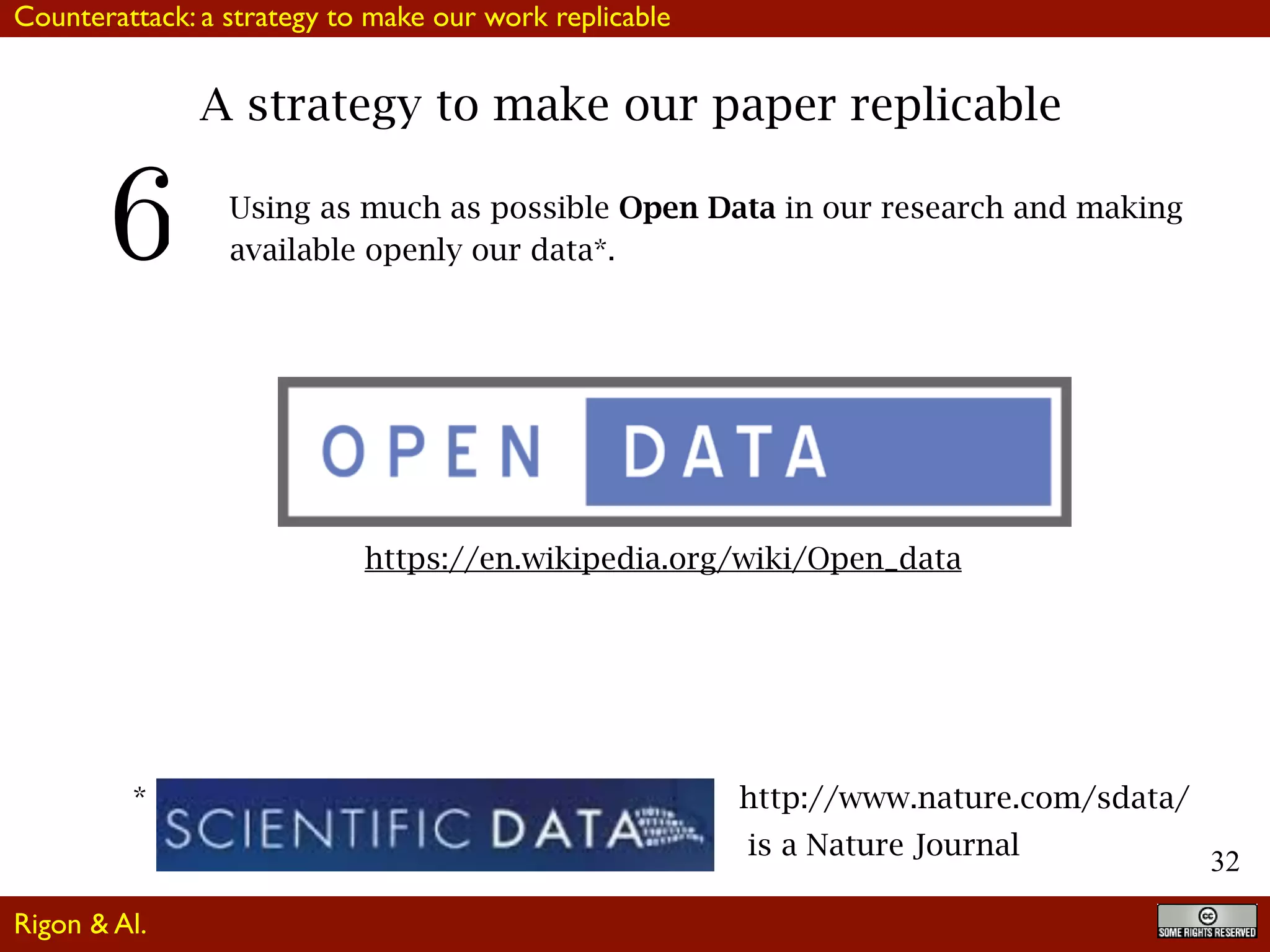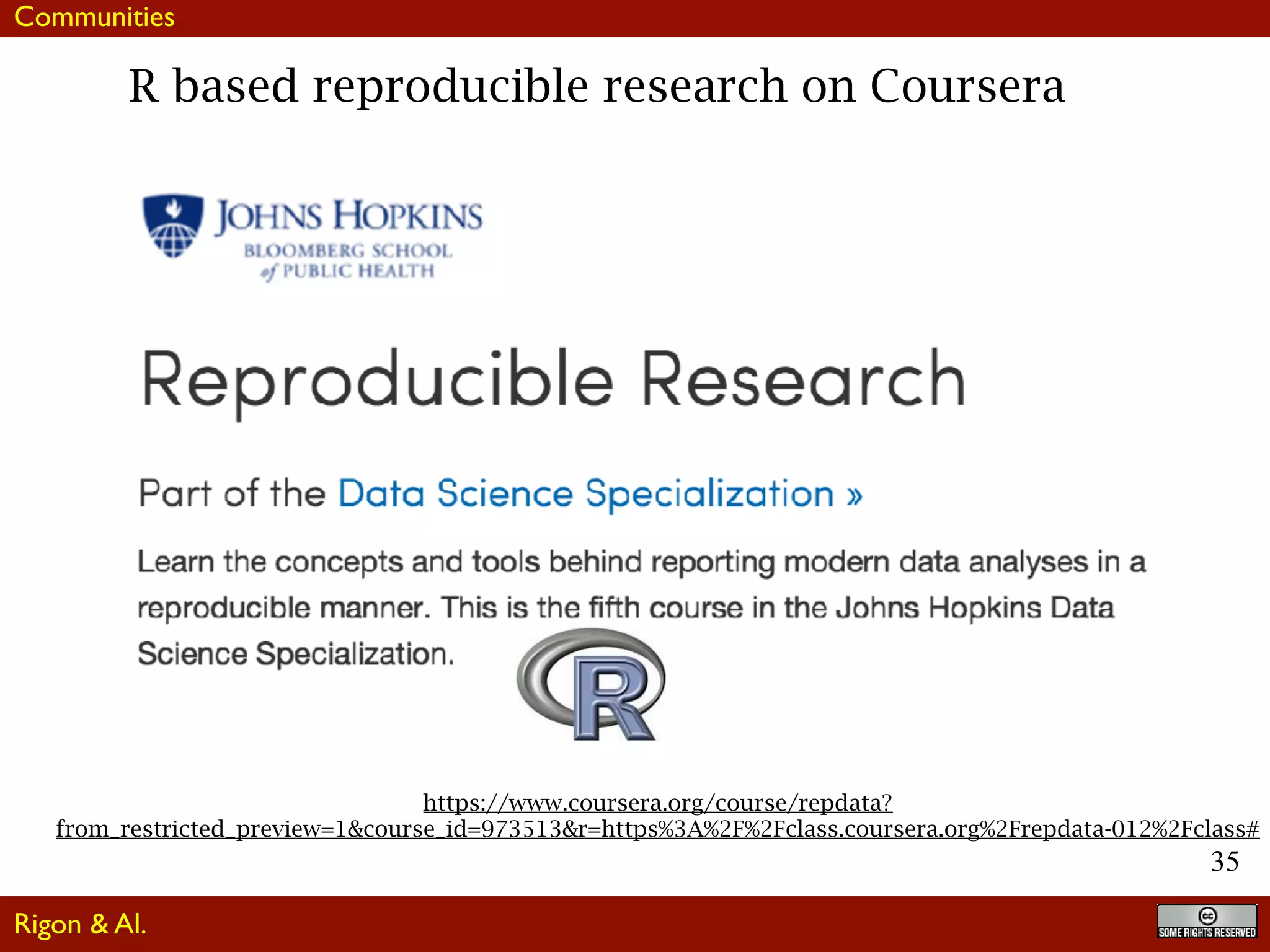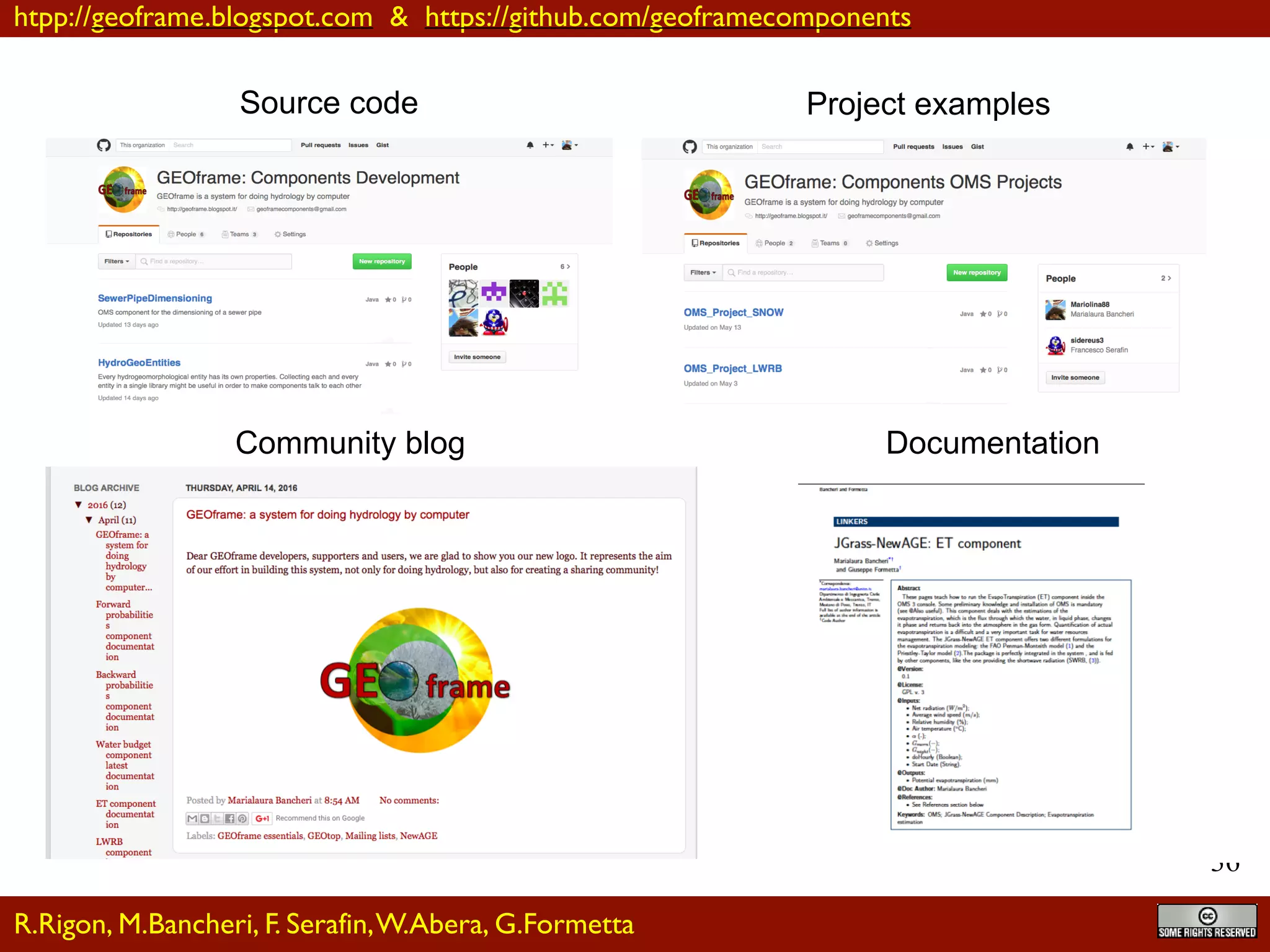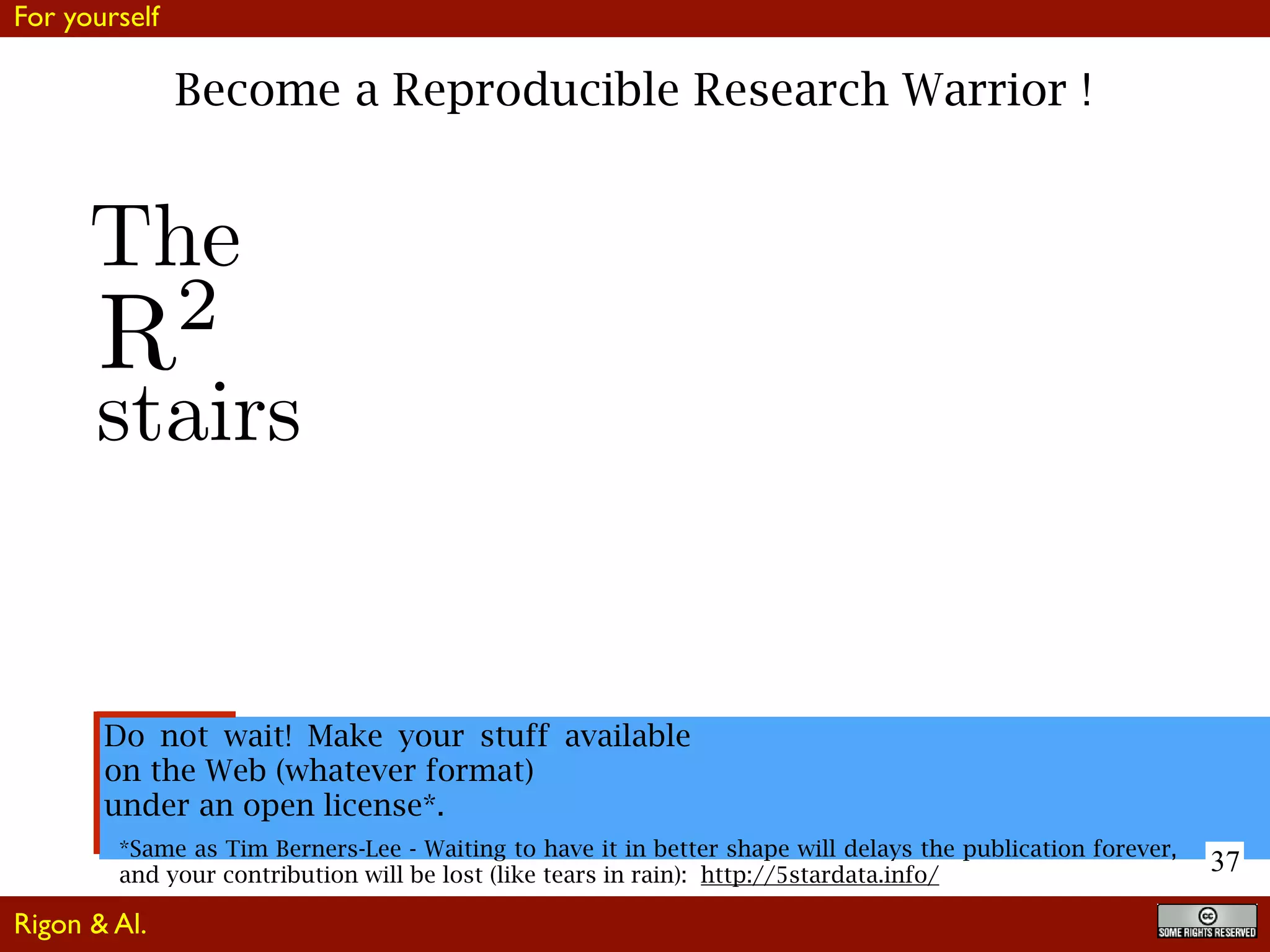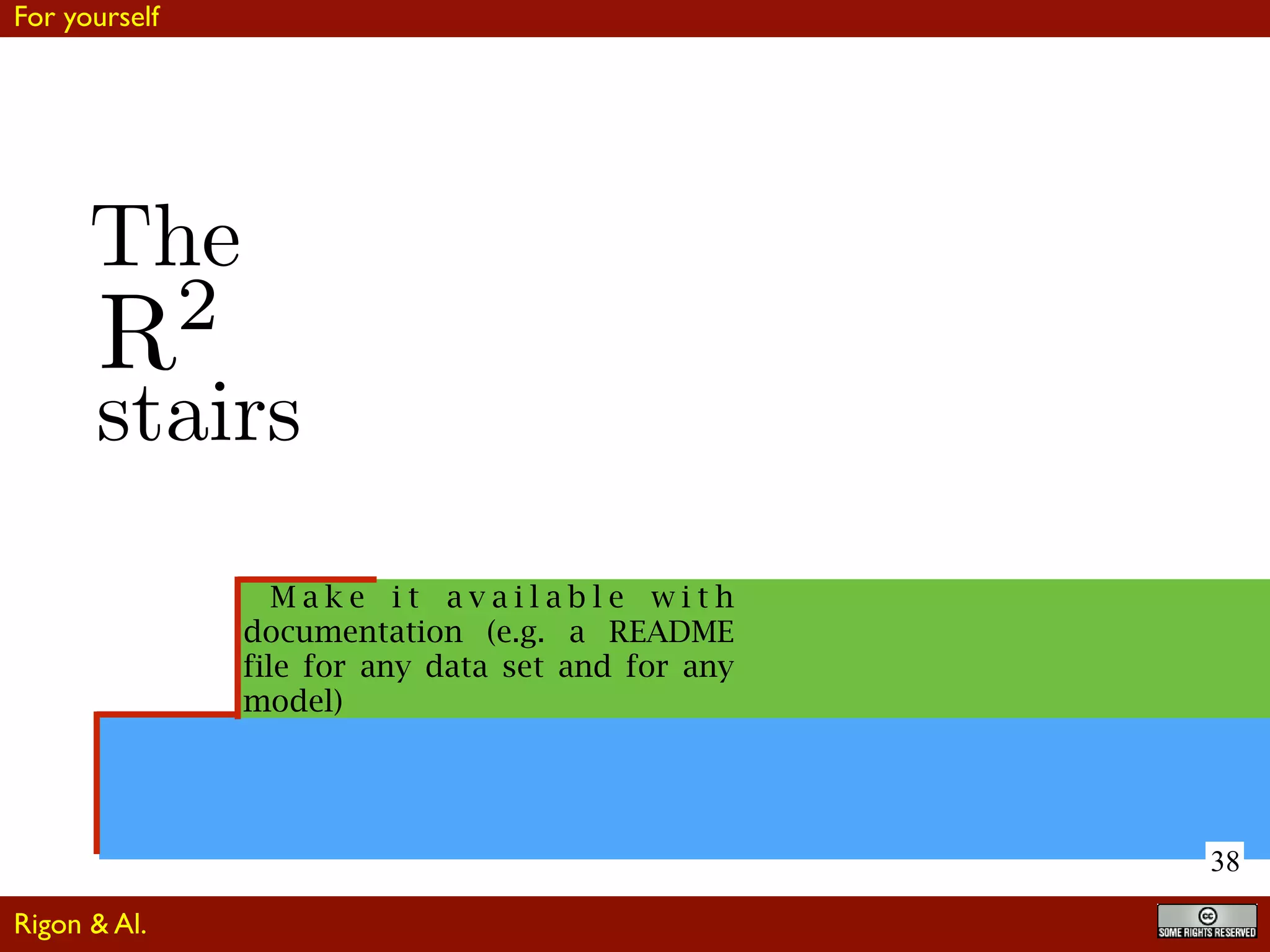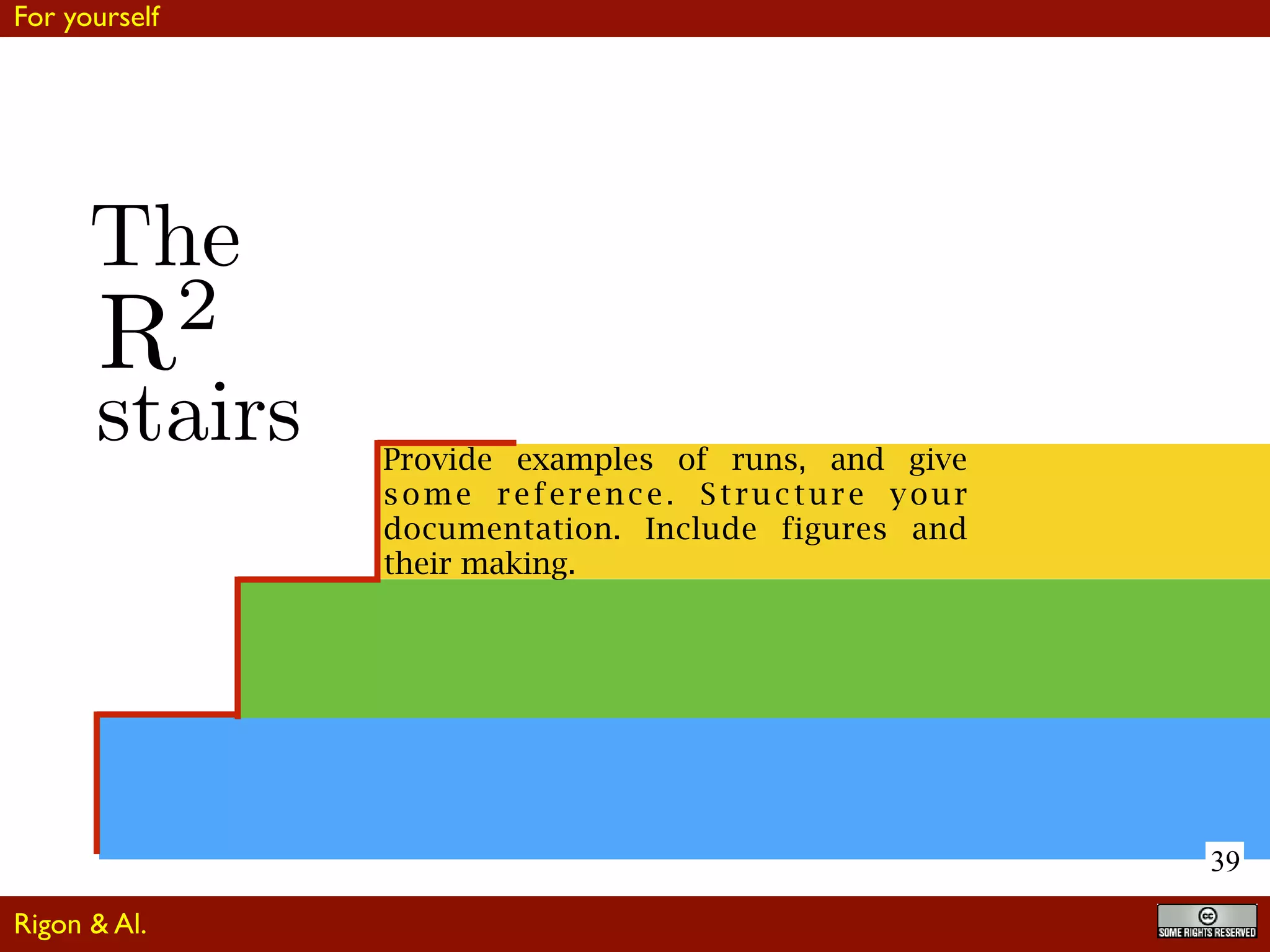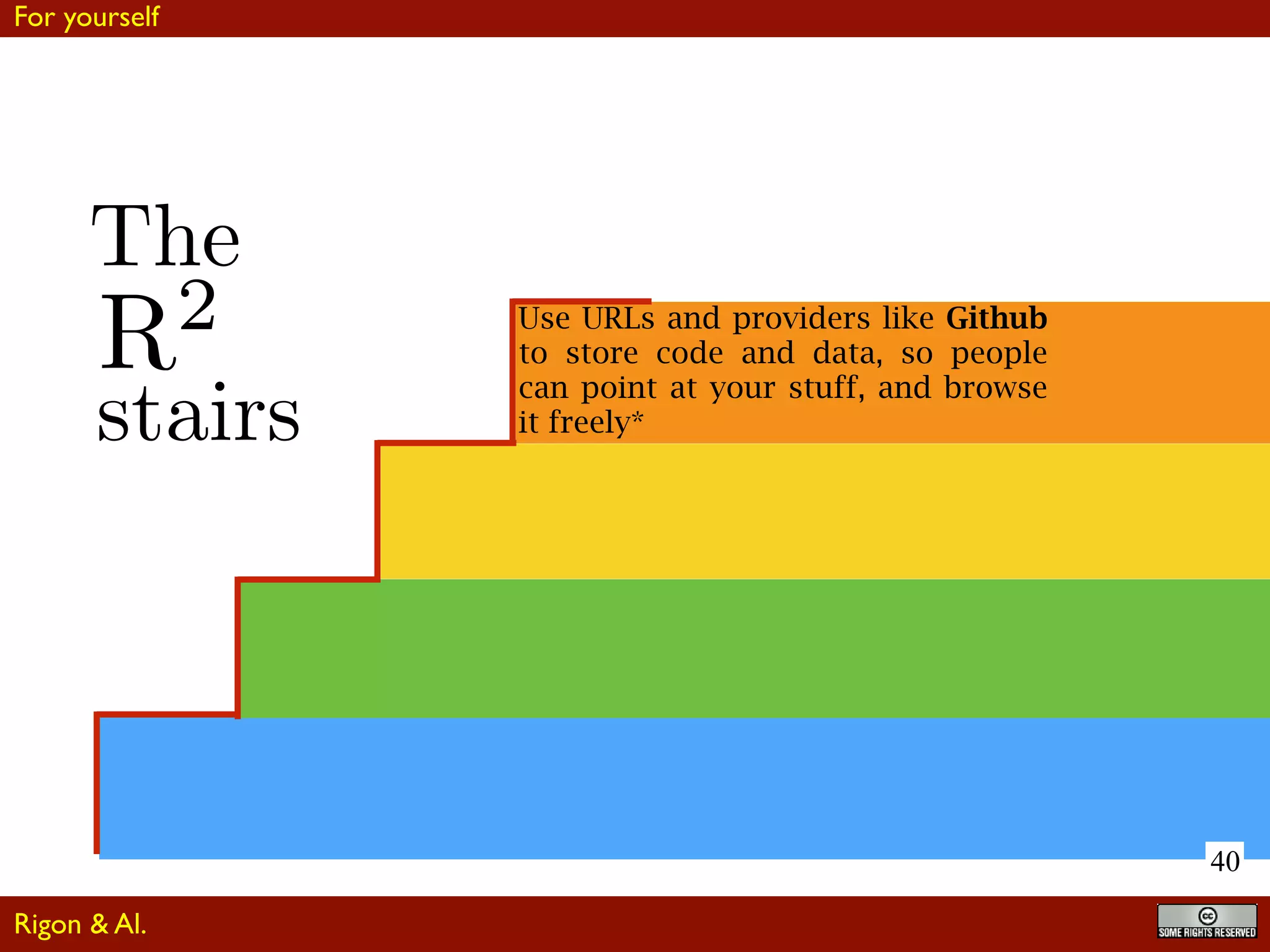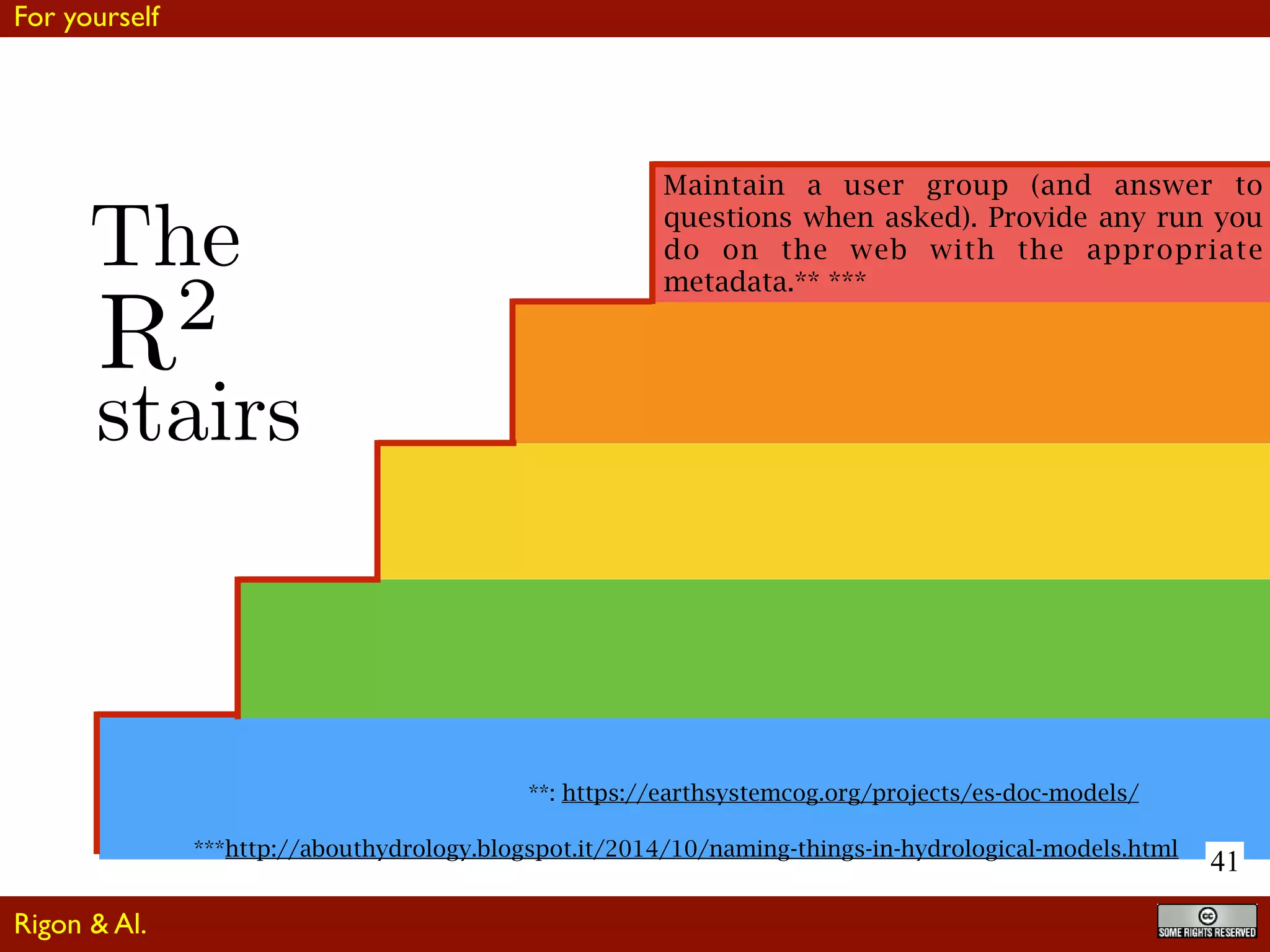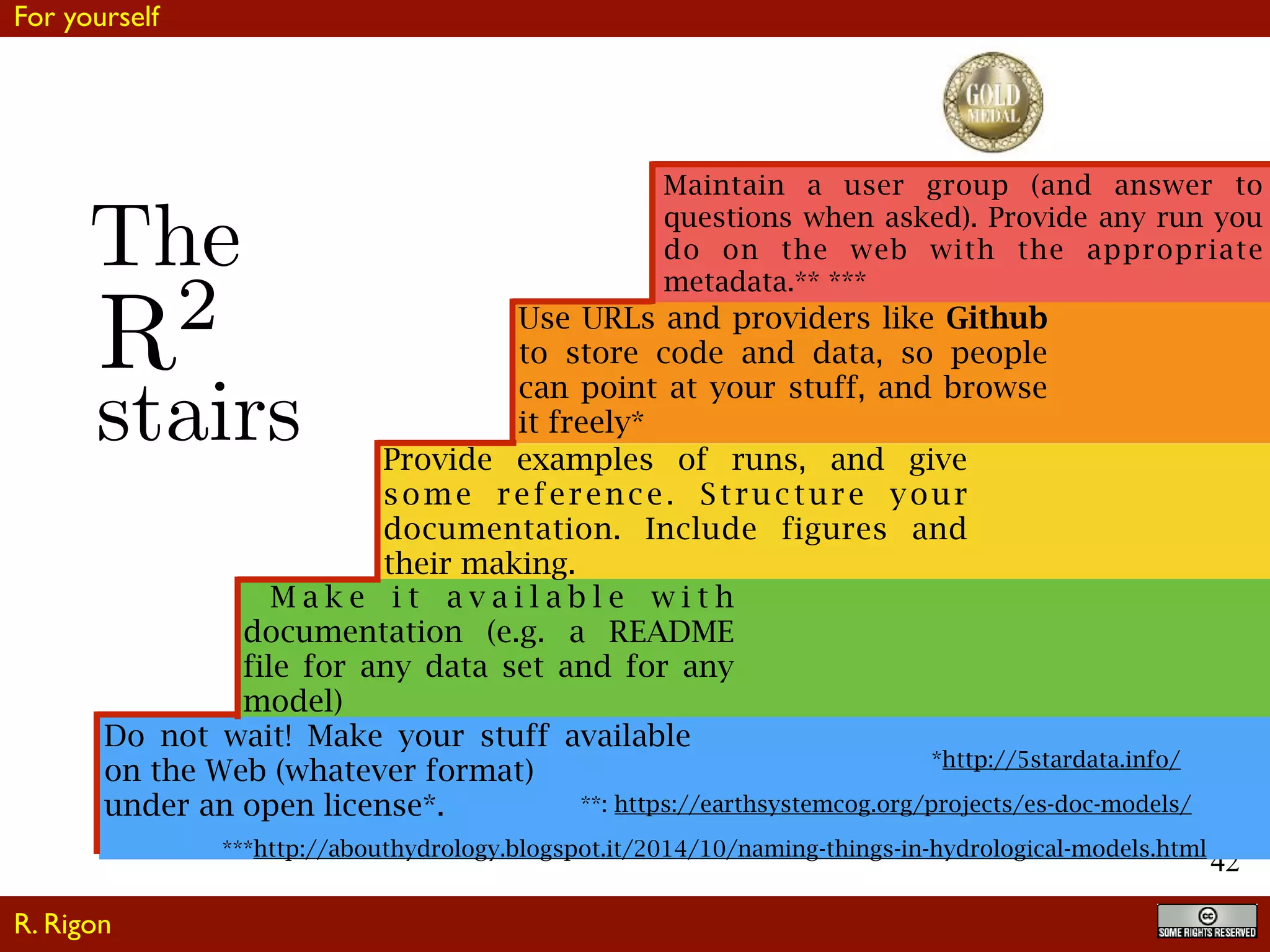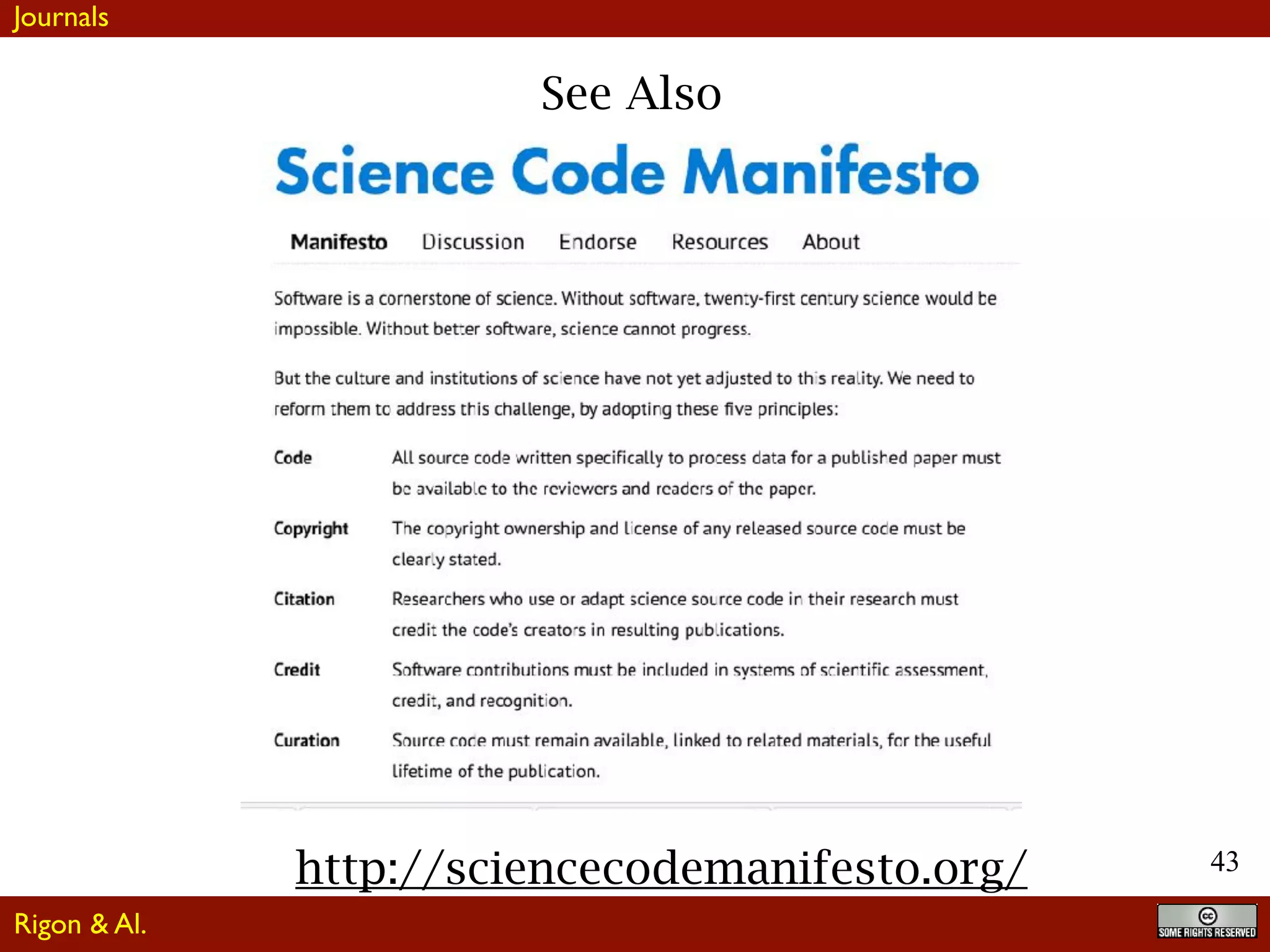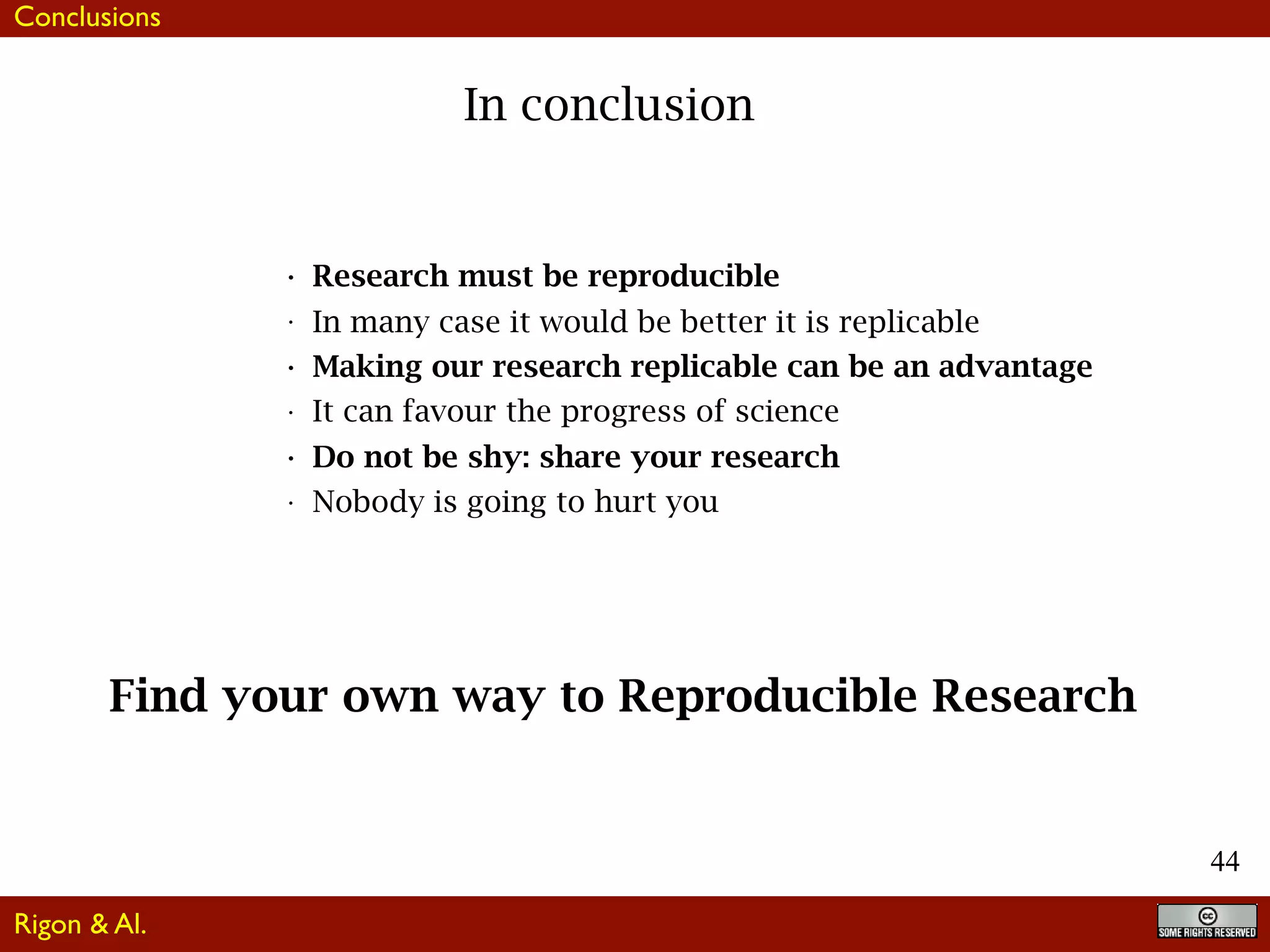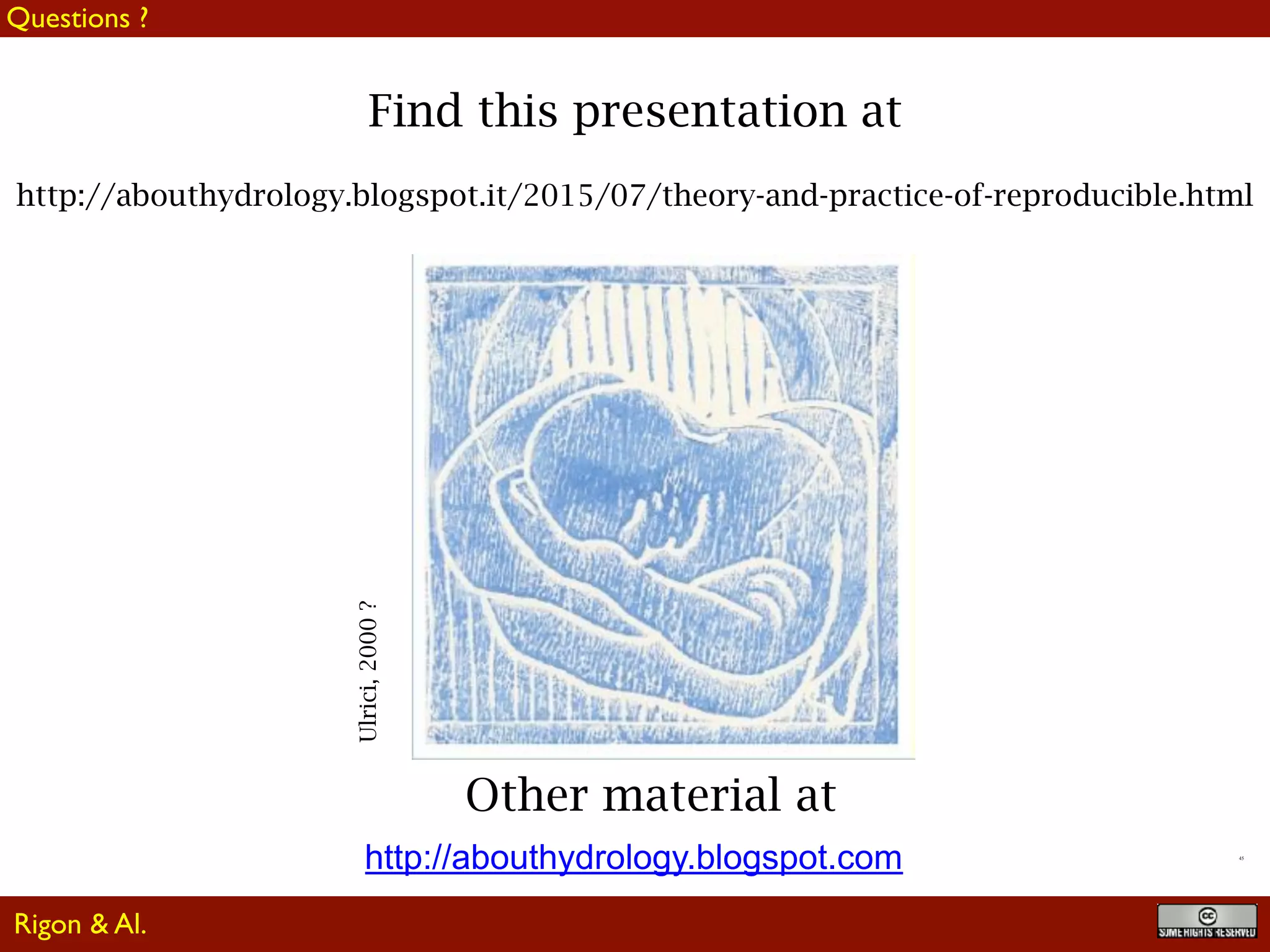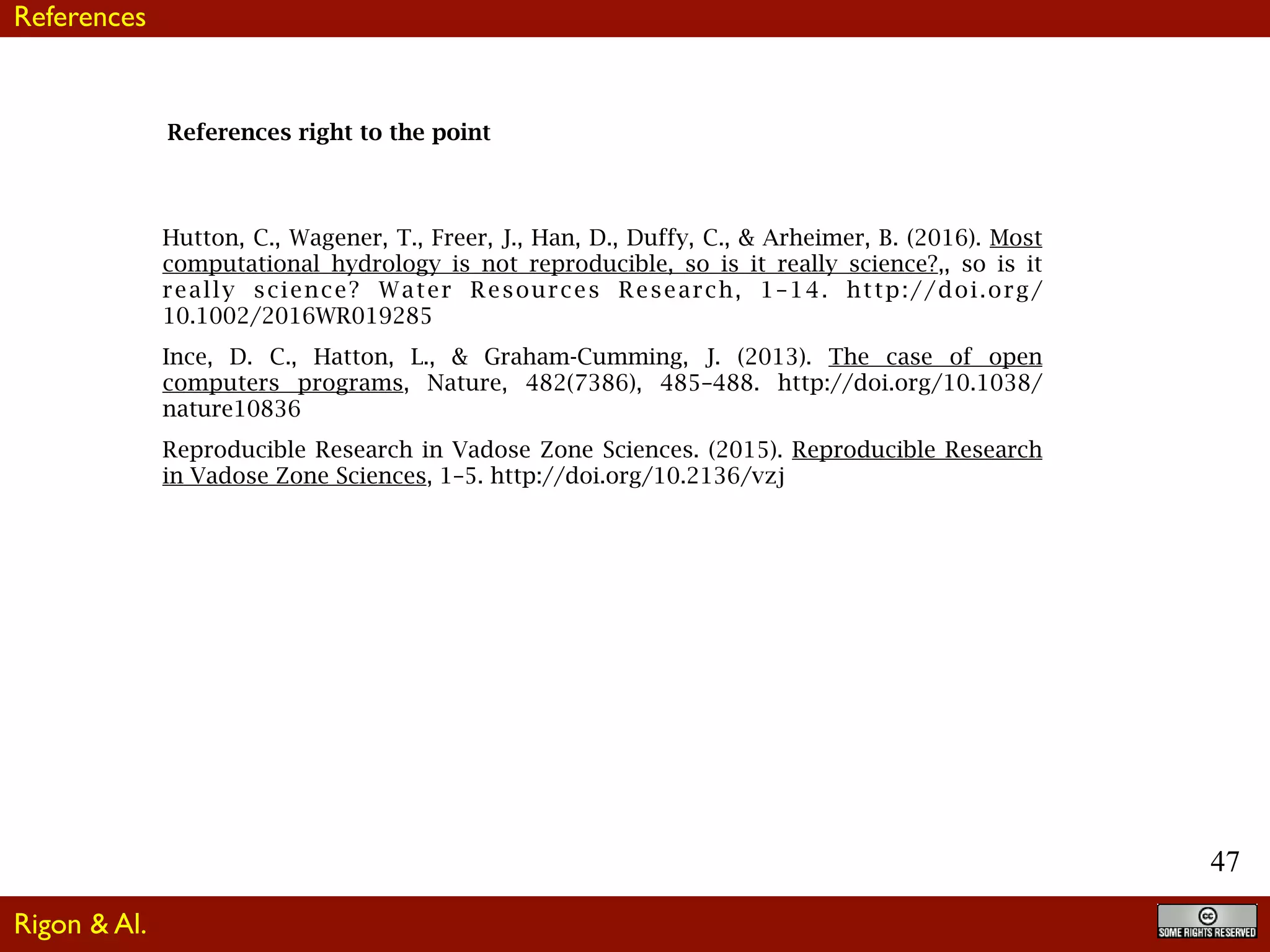The document discusses the theory and practice of reproducible research, emphasizing the importance of making scientific findings accessible for verification by others. It highlights the challenges in reproducibility and provides a case study on the hydrological modeling system JGrass-NewAGE, detailing its predictive capabilities and the methodologies involved in hydrological forecasting. The document suggests that effective collaboration and software availability are essential for enhancing the reproducibility of scientific research.
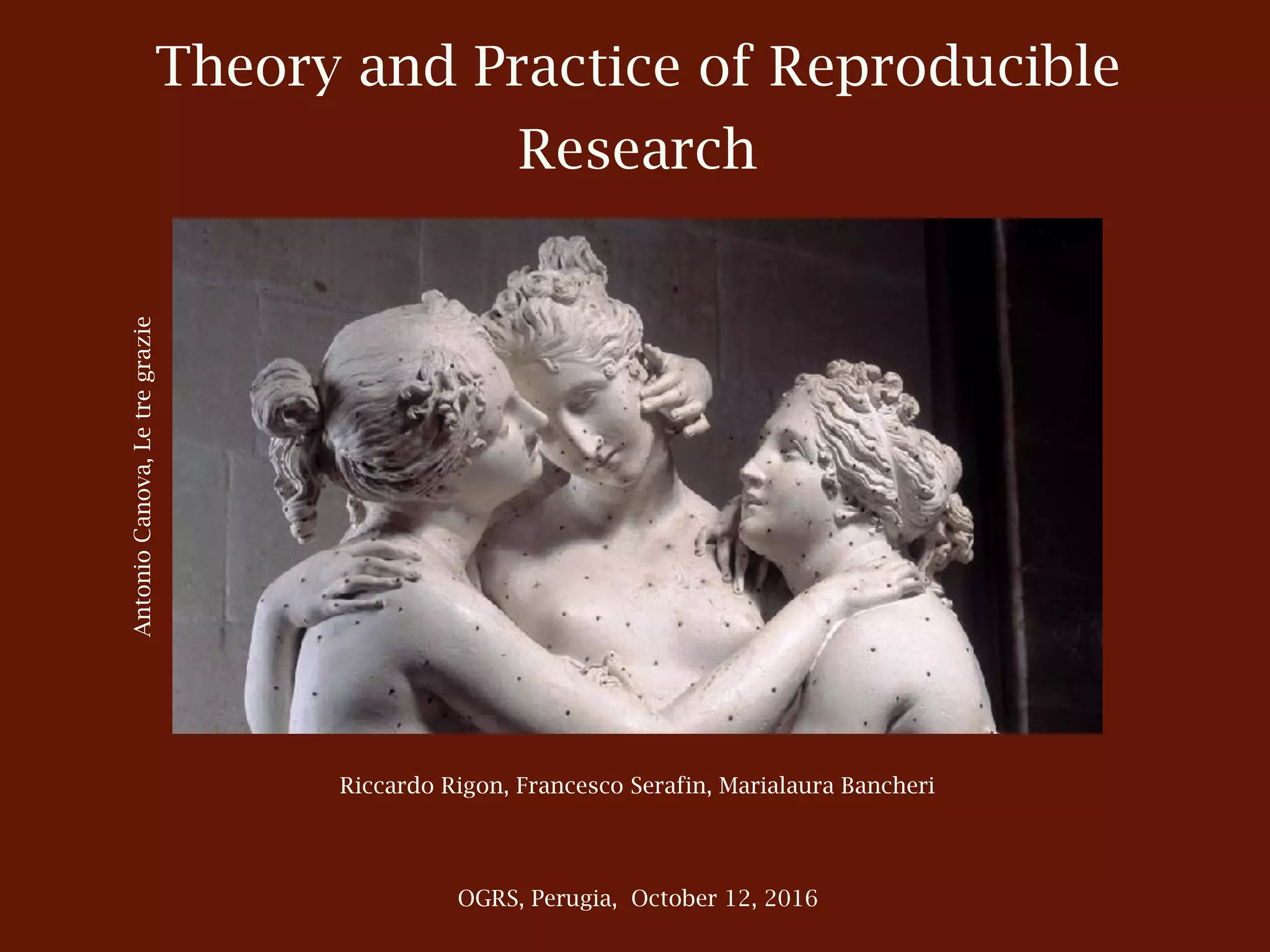
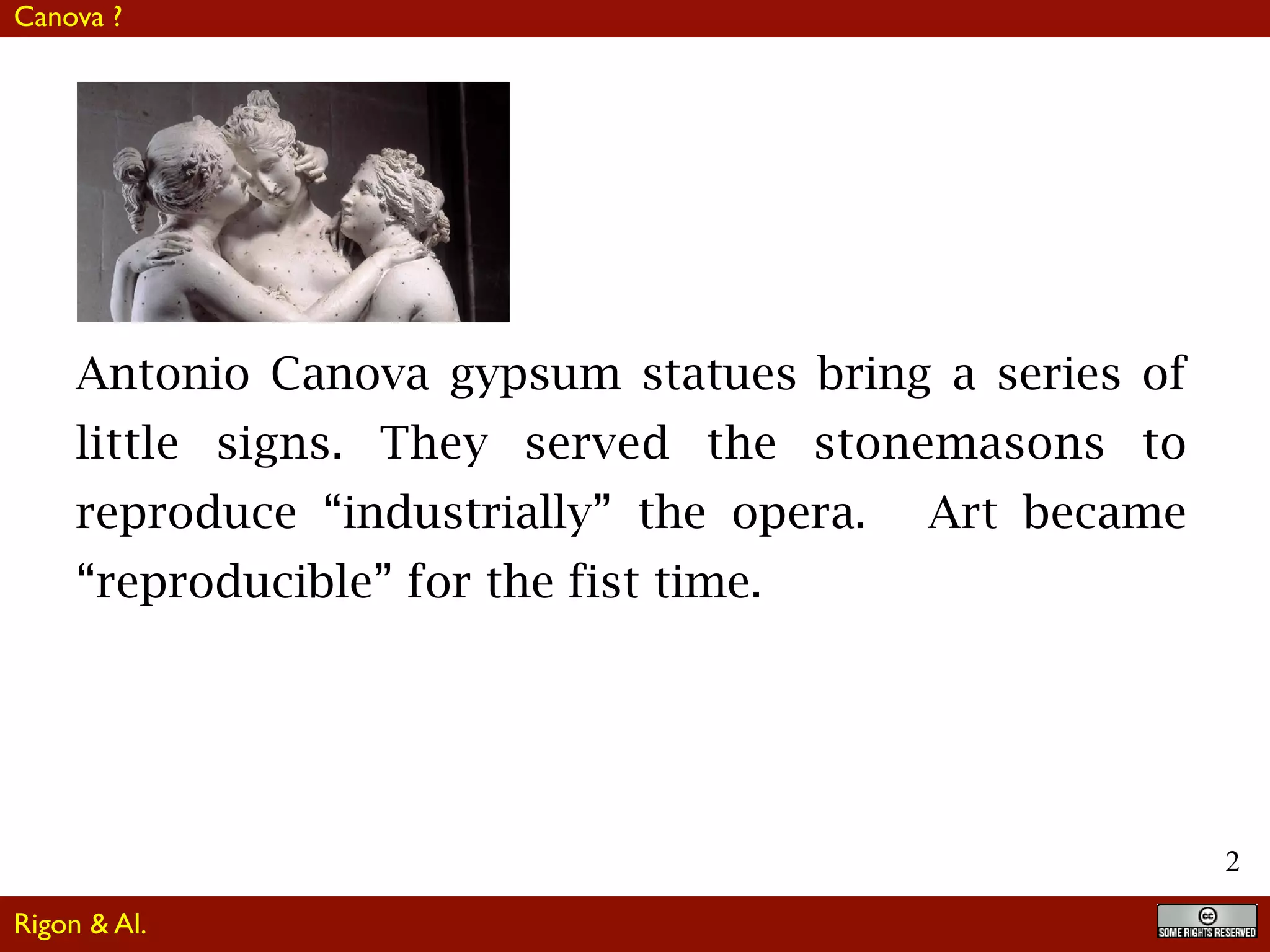


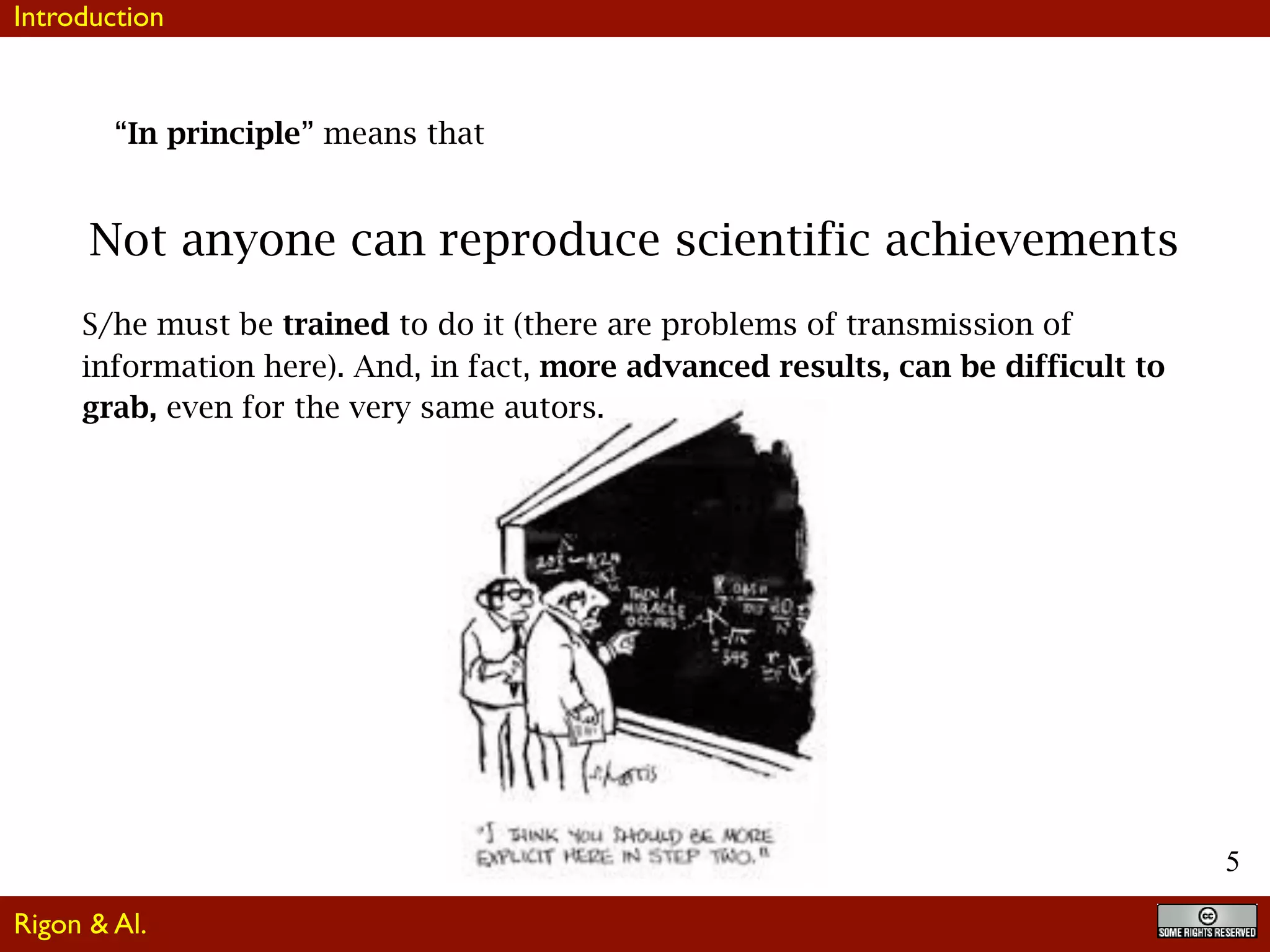
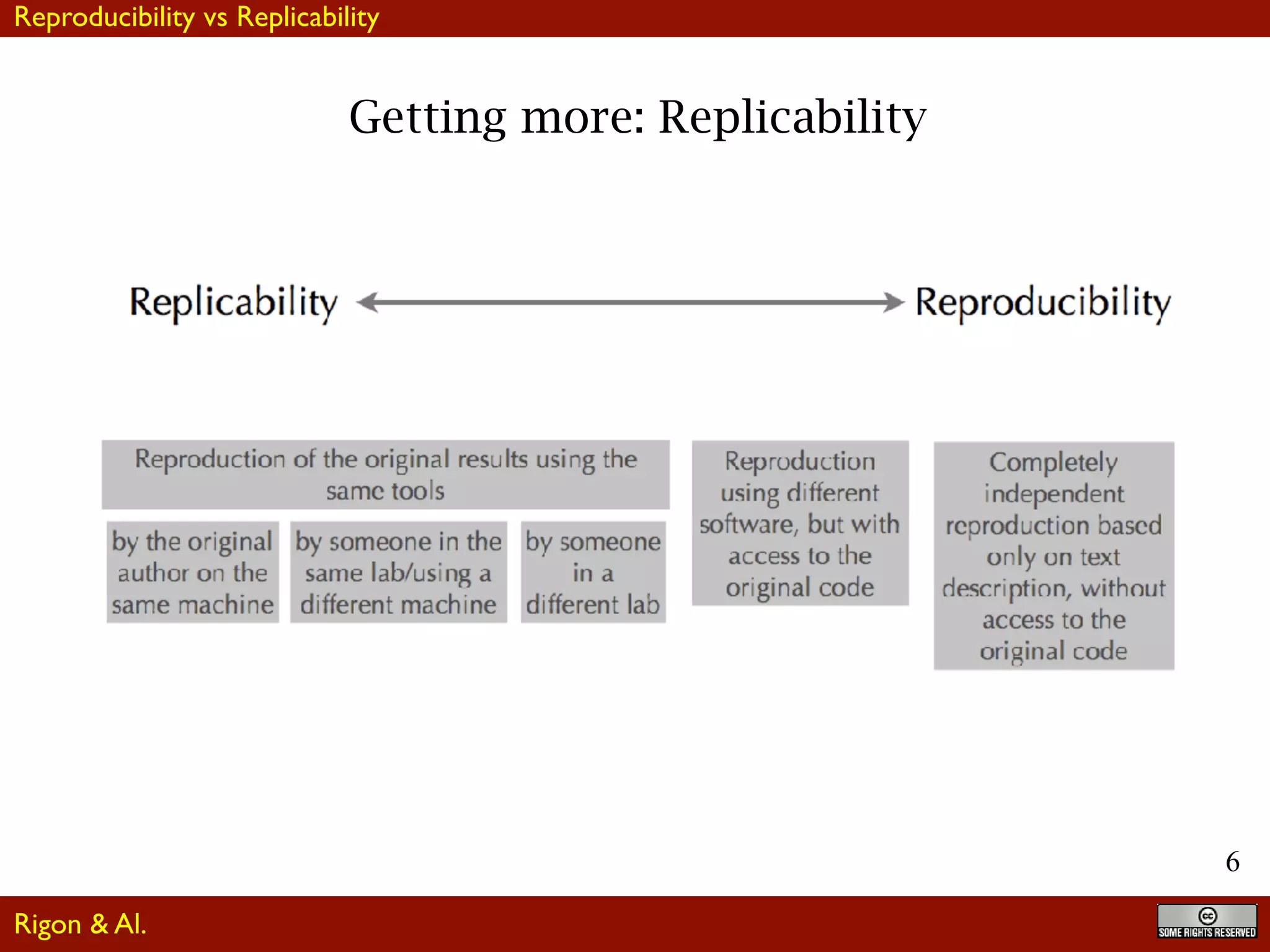
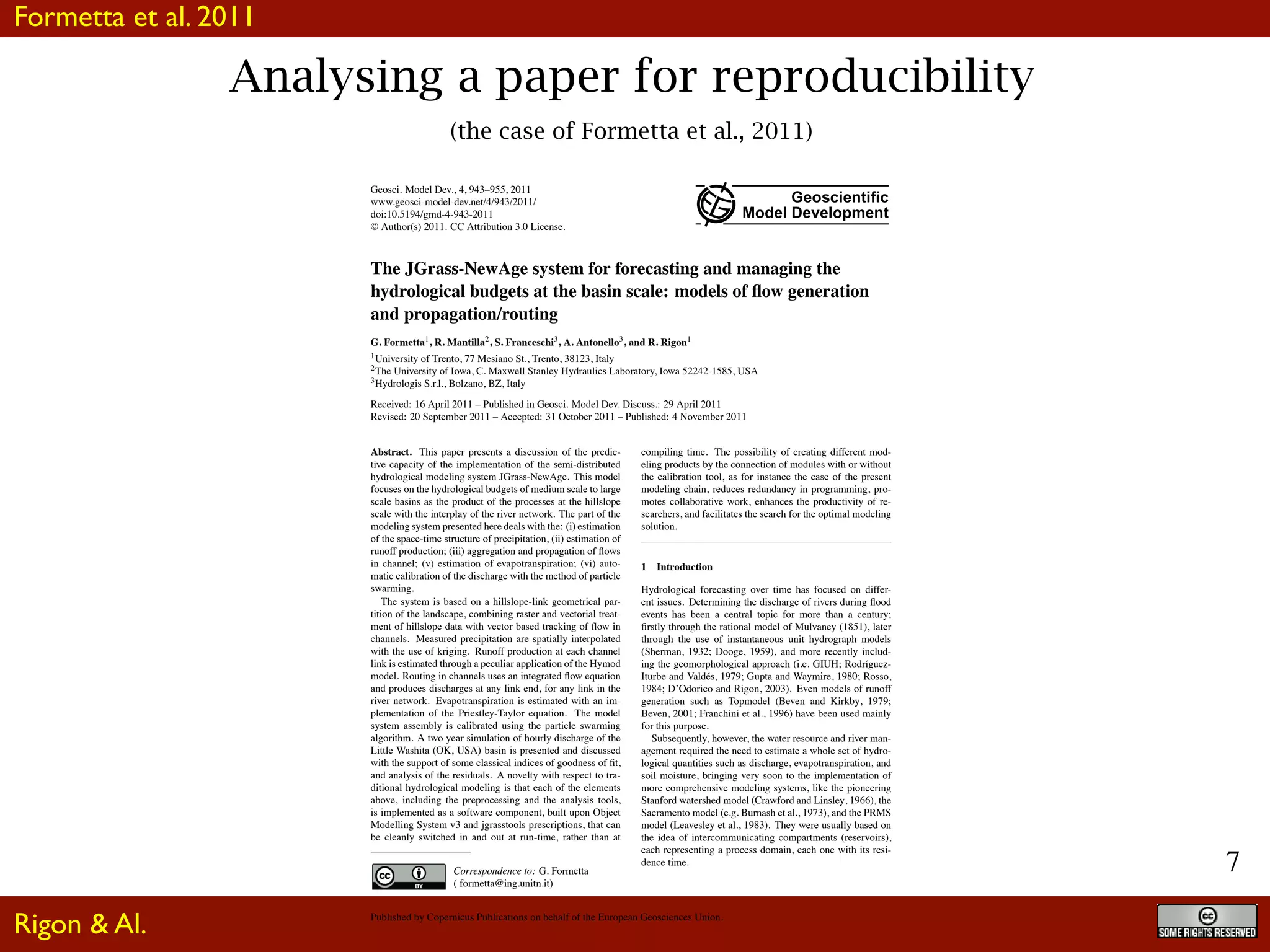
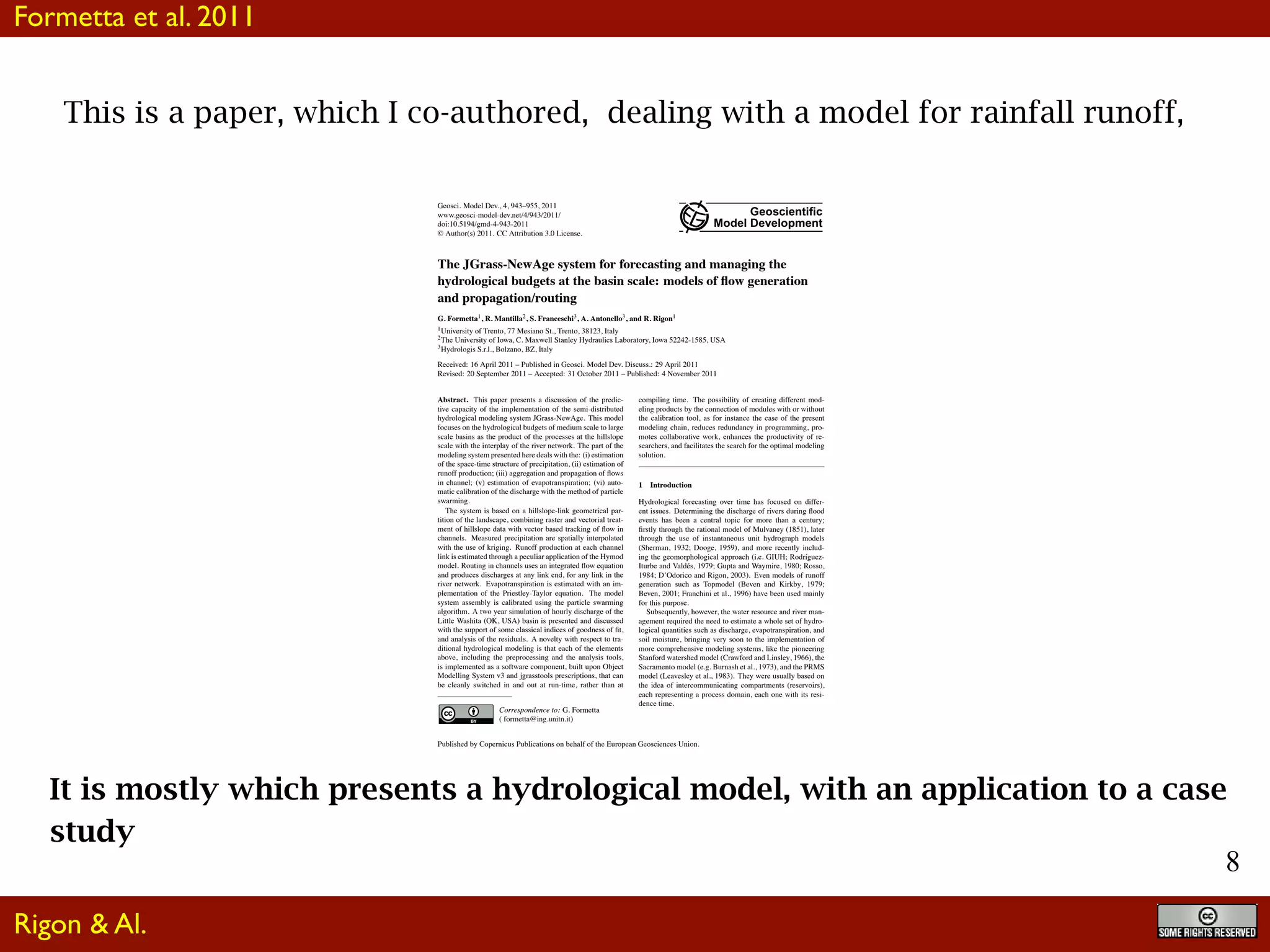
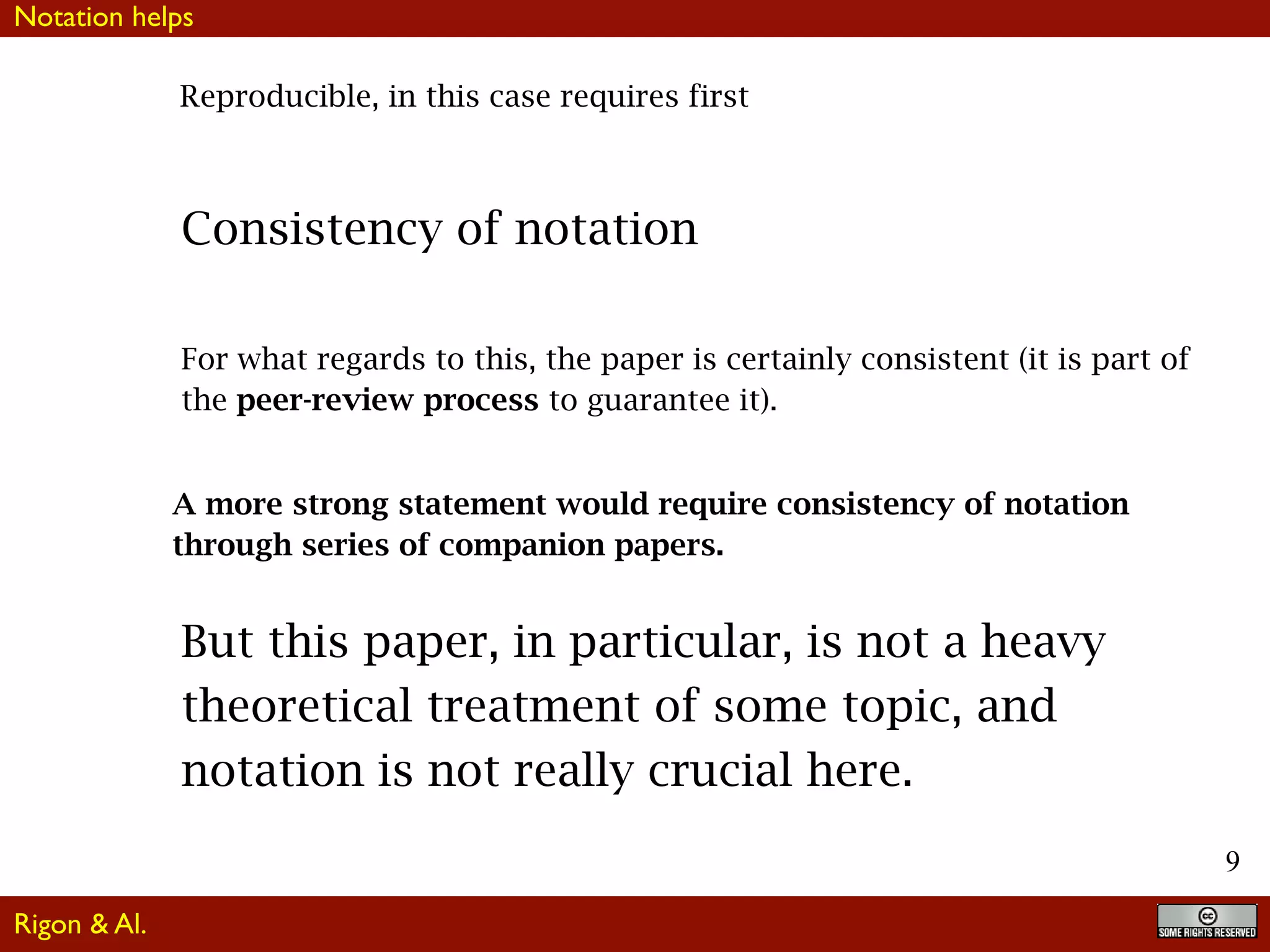
![10
Different story for this paper
(the case of Botter et al., 2010)
Click
Here
for
Full
Article
Transport in the hydrologic response: Travel time
distributions, soil moisture dynamics, and the old
water paradox
Gianluca Botter,1
Enrico Bertuzzo,2
and Andrea Rinaldo1,2
Received 8 July 2009; revised 23 October 2009; accepted 29 October 2009; published 12 March 2010.
[1] We propose a mathematical framework for the general definition and computation of
travel time distributions defined by the closure of a catchment control volume, where the
input flux is an arbitrary rainfall pattern and the output fluxes are green and blue water
flows (namely, evapotranspiration and the hydrologic response embedding runoff
production through soil water dynamics). The relevance of the problem is both practical,
owing to implications in hydrologic watershed modeling, and conceptual for the linkages
and the explanations the theory provides, chiefly concerning the role of geomorphology,
climate, soils, and vegetation through soil water dynamics and the treatment of the so‐
called old water paradox. The work focuses in particular on the origins of the conditional
and time‐variant nature of travel time distributions and on the differences between unit
hydrographs and travel time distributions. Both carrier flow and solute matter transport in
the control volume are accounted for coherently. The key effect of mixing processes
occurring within runoff production is also investigated, in particular by a model that
assumes that mobilization of soil water involves randomly sampled particles from the
available storage. Travel time distributions are analytically expressed in terms of the major
water fluxes driving soil moisture dynamics, irrespectively of the specific model used to
compute them. Relevant numerical examples and a set of generalized applications are
provided and discussed.
Citation: Botter, G., E. Bertuzzo, and A. Rinaldo (2010), Transport in the hydrologic response: Travel time distributions, soil
moisture dynamics, and the old water paradox, Water Resour. Res., 46, W03514, doi:10.1029/2009WR008371.
1. Introduction
[2] The age of water (or residence time) represents the
time spent by water molecules ideally sampled from a given
hydrologic system within the reference control volume
(measured since the entry through rainfall). Thus, the age of
water blends in a single quantitative attribute information
about hydrological and chemical storages, flow pathways,
and water sources [e.g., McGuire and McDonnell, 2006].
Several field observations (especially built through exten-
sive rainfall/runoff dating by isotope hydrology) and a few
theoretical results have established the so‐called “old water
paradox,” according to which a sizable part of the runoff
within the hydrologic response of catchment transport vo-
lumes is constituted by aged water particles (i.e., by water
particles injected at times preceding the event causally re-
lated to the observed runoff) [e.g., Maloszewski and Zuber,
1982; McDonnell, 1990; McDonnell et al., 1991; Stewart
and McDonnell, 1991; Wilson et al., 1991a, 1991b;
Leaney et al., 1993; Rodhe et al., 1996; Cirmo and
McDonnell, 1998; Nyberg et al., 1999; Peters and
Ratcliffe, 1998; Burns et al., 1998; Weiler et al., 2003;
McGuire et al., 2007; Botter et al., 2007, 2008a, 2009]. The
release of old water has been explained by the propagation
of pressure waves induced by precipitation inputs with a
celerity exceeding the pore water velocity [e.g., Beven,
1981, 1989b], including displacement of water previously
immobilized within the soil matrix into preferential flow
pathways [e.g., Beven and Germann, 1982]. However, some
of the physical processes controlling the release of preevent
water from catchments are still poorly understood or
roughly modeled, and the observational data do not suggest
either universal behaviors, nor do they support linear and
time‐invariant behaviors as assumed by unit hydrograph
schemes [e.g., Weiler and McDonnell, 2006]. The com-
plexity of the mixing patterns involving event and preevent
waters in hillslopes is partly a byproduct of the structural
complexity of subsurface environments, which are typically
characterized by pronounced heterogeneity and time vari-
able connectivity of flow pathways. For this reason, it is
inappropriate to use the point‐scale physical laws deter-
mining the movement of water and solutes within hillslopes
to make predictions at larger scales because of the nonlin-
earity of flow processes and the uncertain distribution of
hydrologic, geological and morphological properties of
control volumes [e.g., Beven, 1989a, 2006; Kirchner, 2009].
Hence, lumped approaches are frequently employed to
describe in an effective manner the overall behavior of
hillslopes/catchments. In particular, the water travel time
1
Dipartimento di Ingegneria Idraulica Marittima Ambientale e
Geotecnica, Università degli Studi di Padova, Padua, Italy.
2
Laboratory of Ecohydrology, Faculte´ ENAC, Ecole Polytechinque
Federale, Lausanne, Switzerland.
Copyright 2010 by the American Geophysical Union.
0043‐1397/10/2009WR008371
WATER RESOURCES RESEARCH, VOL. 46, W03514, doi:10.1029/2009WR008371, 2010
W03514 1 of 18
R. Rigon
Botter et al., 2010](https://image.slidesharecdn.com/r5-perugia-161011101432/75/Research-reproducibility-Code-etc-10-2048.jpg)
![11
This is an outstanding paper dealing with transport for residence time, which
I read several times during the last months, in order to reproduce their
research (with my own tools)
Click
Here
for
Full
Article
Transport in the hydrologic response: Travel time
distributions, soil moisture dynamics, and the old
water paradox
Gianluca Botter,1
Enrico Bertuzzo,2
and Andrea Rinaldo1,2
Received 8 July 2009; revised 23 October 2009; accepted 29 October 2009; published 12 March 2010.
[1] We propose a mathematical framework for the general definition and computation of
travel time distributions defined by the closure of a catchment control volume, where the
input flux is an arbitrary rainfall pattern and the output fluxes are green and blue water
flows (namely, evapotranspiration and the hydrologic response embedding runoff
production through soil water dynamics). The relevance of the problem is both practical,
owing to implications in hydrologic watershed modeling, and conceptual for the linkages
and the explanations the theory provides, chiefly concerning the role of geomorphology,
climate, soils, and vegetation through soil water dynamics and the treatment of the so‐
called old water paradox. The work focuses in particular on the origins of the conditional
and time‐variant nature of travel time distributions and on the differences between unit
hydrographs and travel time distributions. Both carrier flow and solute matter transport in
the control volume are accounted for coherently. The key effect of mixing processes
occurring within runoff production is also investigated, in particular by a model that
assumes that mobilization of soil water involves randomly sampled particles from the
available storage. Travel time distributions are analytically expressed in terms of the major
water fluxes driving soil moisture dynamics, irrespectively of the specific model used to
compute them. Relevant numerical examples and a set of generalized applications are
provided and discussed.
Citation: Botter, G., E. Bertuzzo, and A. Rinaldo (2010), Transport in the hydrologic response: Travel time distributions, soil
moisture dynamics, and the old water paradox, Water Resour. Res., 46, W03514, doi:10.1029/2009WR008371.
1. Introduction
[2] The age of water (or residence time) represents the
time spent by water molecules ideally sampled from a given
hydrologic system within the reference control volume
(measured since the entry through rainfall). Thus, the age of
water blends in a single quantitative attribute information
about hydrological and chemical storages, flow pathways,
and water sources [e.g., McGuire and McDonnell, 2006].
Several field observations (especially built through exten-
sive rainfall/runoff dating by isotope hydrology) and a few
theoretical results have established the so‐called “old water
paradox,” according to which a sizable part of the runoff
within the hydrologic response of catchment transport vo-
lumes is constituted by aged water particles (i.e., by water
particles injected at times preceding the event causally re-
lated to the observed runoff) [e.g., Maloszewski and Zuber,
1982; McDonnell, 1990; McDonnell et al., 1991; Stewart
and McDonnell, 1991; Wilson et al., 1991a, 1991b;
Leaney et al., 1993; Rodhe et al., 1996; Cirmo and
McDonnell, 1998; Nyberg et al., 1999; Peters and
Ratcliffe, 1998; Burns et al., 1998; Weiler et al., 2003;
McGuire et al., 2007; Botter et al., 2007, 2008a, 2009]. The
release of old water has been explained by the propagation
of pressure waves induced by precipitation inputs with a
celerity exceeding the pore water velocity [e.g., Beven,
1981, 1989b], including displacement of water previously
immobilized within the soil matrix into preferential flow
pathways [e.g., Beven and Germann, 1982]. However, some
of the physical processes controlling the release of preevent
water from catchments are still poorly understood or
roughly modeled, and the observational data do not suggest
either universal behaviors, nor do they support linear and
time‐invariant behaviors as assumed by unit hydrograph
schemes [e.g., Weiler and McDonnell, 2006]. The com-
plexity of the mixing patterns involving event and preevent
waters in hillslopes is partly a byproduct of the structural
complexity of subsurface environments, which are typically
characterized by pronounced heterogeneity and time vari-
able connectivity of flow pathways. For this reason, it is
inappropriate to use the point‐scale physical laws deter-
mining the movement of water and solutes within hillslopes
to make predictions at larger scales because of the nonlin-
earity of flow processes and the uncertain distribution of
hydrologic, geological and morphological properties of
control volumes [e.g., Beven, 1989a, 2006; Kirchner, 2009].
Hence, lumped approaches are frequently employed to
describe in an effective manner the overall behavior of
hillslopes/catchments. In particular, the water travel time
1
Dipartimento di Ingegneria Idraulica Marittima Ambientale e
Geotecnica, Università degli Studi di Padova, Padua, Italy.
2
Laboratory of Ecohydrology, Faculte´ ENAC, Ecole Polytechinque
Federale, Lausanne, Switzerland.
Copyright 2010 by the American Geophysical Union.
0043‐1397/10/2009WR008371
WATER RESOURCES RESEARCH, VOL. 46, W03514, doi:10.1029/2009WR008371, 2010
W03514 1 of 18
It is mostly a theoretical paper, with an application to an idealised case study
Botter et al., 2010
Rigon & Al.](https://image.slidesharecdn.com/r5-perugia-161011101432/75/Research-reproducibility-Code-etc-11-2048.jpg)

